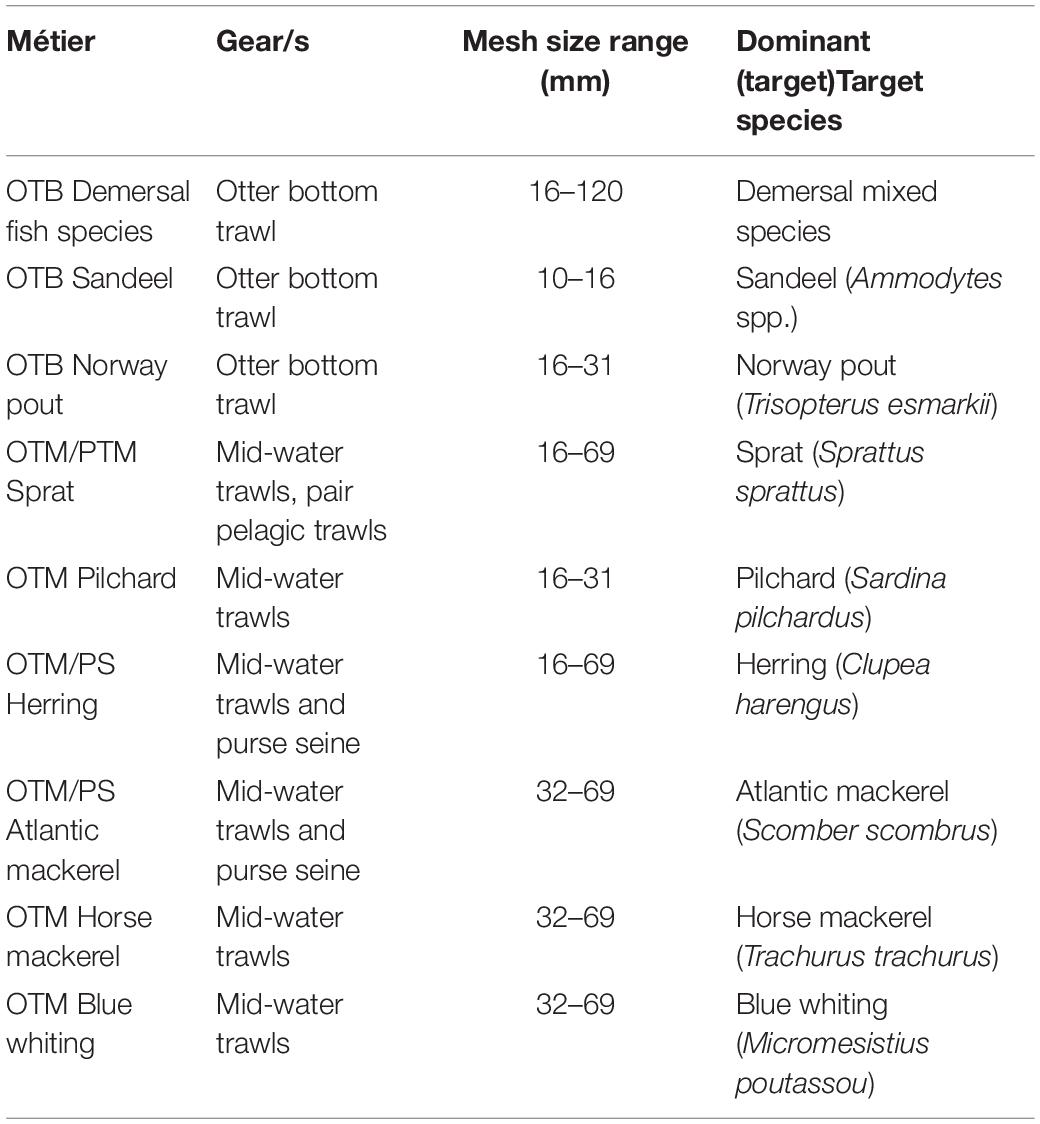- 1Section for Ecosystem Based Marine Management, National Institute of Aquatic Resources, Technical University of Denmark, Lyngby, Denmark
- 2Danish Pelagic Producers Organization, Axelborg, Denmark
Mesopelagic fish species represent a large potentially unexploited resource for the fishing industry and the fish meal, oil, nutraceutical, and pharmaceutical production. However, thorough investigation on ecological sustainability and socio-economic viability are fundamental prerequisites for potential exploitation. The current study explores the economic viability of a potential mesopelagic fishery investigating minimum catch rates, under the assumption of previous assessments of biological sustainability of such exploitation. We analyzed fishery data from the North-East Atlantic fisheries of the Danish large pelagic fleet from 2015 to 2019, by comparing the combined data on fishing dynamics and cost-structures with data from interviews of key pelagic producer organization representatives to develop scenarios of profitability. The results show full year-round fleet occupation with the ongoing fisheries, exposing the need of switching from existing activities, or investing into new vessels for conducting potential mesopelagic fishery. Economic analyses revealed that the minimum revenue to break even (zero profit) by trip varies among métiers between 60,000 and 200,000 euro showing strong positive correlation with vessel sizes. High profitability was discovered for herring, Atlantic mackerel and blue whiting fisheries while low profitability was observed for the Norway pout fishery. Due to the lack of mesopelagic fishery data, different scenarios of profitability were investigated as informed by the pelagic catch sector stakeholder perceptions of prices and costs and compared to current economic dynamics. A high break-even revenue per trip was forecasted given the increased perceived costs for fuel, modifications of gears and on-board processing methods and potential new vessel investments. High profitability may be reached if the catches exceed 220–1,060 tons per trip depending on costs and vessel storage capacity. If the conservation methods are improved from current refrigerated sea water, fishing trips could last longer than 5 days, being the major limiting economic factor for potential mesopelagic fishery. Future investigations on realistic mesopelagic catches, trip durations and spatio-temporal distribution of fisheries in relation to location, resource abundance, fishing rights, storage and conservation methods will be essential to test the robustness of the scenarios proposed in this study, and will in turn benefit of the economic requirements evaluated herein.
Introduction
Capture fishery represents an estimated global value of USD 151 billion corresponding to roughly 97 million tons of wild caught fish per year (FAO, 2020). Approximately 3.3 billion people are dependent on this food source for 20% of their daily intake of animal protein, and more than 38 million people have direct employment in fisheries activities in 2018 (FAO, 2020). The models by the United Nations Food and Agriculture Organization (FAO) show that around 66% of exploited fish and shellfish stocks are currently fished sustainably and around 34% are fished above biological sustainable limits in 2017 (FAO, 2020). However, due to a growing human population, the demand for human food, resources, and employment continues to increase (Costello et al., 2020).
Mesopelagic (200–1,000 m depth) marine living resources in the world oceans represent a large unexploited biomass (St. John et al., 2016). Preliminary investigations suggest that there may be a potential for capture fishery exploitation of some mesopelagic species, specifically targeting the Myctophid Benthosema glaciale (Glacier lanternfish) and the Sternoptychida Maurolicus muelleri (Mueller’s pearlside). Both species are small (50–80 mm) and perform diel vertical migration (Ishihara and Kubota, 1997; Sutton et al., 2008; Eigaard et al., 2012; Hudson et al., 2014; Prellezo, 2019; Grimaldo et al., 2020). The high levels of lipid and fatty acid contents found in B. glaciale and M. muelleri (Phleger et al., 1999; Lea et al., 2002; El-Mowafi et al., 2010; Koizumi et al., 2014; Grimaldo et al., 2020) make the species commercially and economically interesting for industrial, neutraceutical, and pharmaceutical purposes (Gjosaeter and Kawaguchi, 1980; Gjosaeter and Tilseth, 1983; Gjosaeter, 1984; Johannesson, 1991; Lamhauge et al., 2008; Tacon and Metian, 2009; Irigoien et al., 2014; Olsen and Torrisen, 2015; Grimaldo et al., 2018, 2020; Davidson et al., 2019). Some trial fisheries and surveys on mesopelagic species have already been conducted in different parts of the world; in the Gulf of Oman, the Indian Ocean, the California Current, and the Northeast Atlantic (Valinassab, 1998; Lamhauge et al., 2008; Sebastine et al., 2013; Davison et al., 2015; Grimaldo et al., 2018, 2020; Malvarosa et al., 2019). But before such potential large-scale exploitation the ecological and the economic sustainability of the fishery needs to be thoroughly assessed.
A comprehensive investigation of the ecosystem and biological sustainability is necessary, evaluating the potential target and by-catch stocks, food web interactions, and biodiversity to assess whether such exploitation is at all ecologically precautionary and sustainable, also in the long-term (Hall, 1999; Branch et al., 2010; Hilborn et al., 2015; Gascuel et al., 2016). Among other, the effects of mesopelagic exploitation on the ecosystem functioning have to be considered. The mesopelagic community provides several essential ecosystem services: the community inhabiting this layer is part of the marine food chain with significant supply to the epipelagic trophic levels and ecosystem, it represent high biodiversity, its extensive biological production and distribution of biomass in the sea, and finally, its important role in carbon sequestration and transportation of carbon to the deep ocean (Gartner, 1993; Ishihara and Kubota, 1997; Lea et al., 2002; Sutton et al., 2008; Branch et al., 2010; Hudson et al., 2014; Irigoien et al., 2014). As such, the resilience of the stocks to future harvesting and climate change scenarios needs to be evaluated as well.
If there is a biomass that could be exploited, such potential exploitation will need assessments of options to sustainably manage and govern the exploitation to establish robust governance systems. Here, the complexity and key interactions of the ecological, economic, social, and governance systems involved needs to be understood (Holling, 2001; Garcia and Rosenberg, 2010; Nielsen et al., 2018). The social acceptance in potentially exploiting new mesopelagic resources will depend on the biological and ecosystem sustainability herein, but it will also depend on analyses of the economic, social, governance, and biological trade-offs and risks involved in mesopelagic exploitation and management (Holling, 2001; Mullon et al., 2009; Ostrom, 2009; van Dijk et al., 2013; Hicks et al., 2016; Soma et al., 2018).
Similar to the ecological sustainability, the economic sustainability of the potential fishery needs to be thoroughly assessed to investigate if the fishery is at all economically viable (Valinassab et al., 2007; van Putten et al., 2012; Malvarosa et al., 2019; Prellezo, 2019). Adaptations or new developments in catch and processing methods will be necessary to efficiently exploit the potential resource, including vessel investments, and gear modifications (e.g., Grimaldo et al., 2018, 2020). The design and development of new fishing methods fit for mesopelagic resource harvesting may lead to efficient fishery, but thorough investigations in fishing patterns and the needed and investments are crucial as it will influence the fishing costs (Grimaldo et al., 2018, 2020; Bigné et al., 2019). Investments into the fishery will among others be more profitable on-board processing methods to deal with the high fat content of the species and their fast deterioration after harvest (Olsen and Torrisen, 2015). This makes the catching methods, catch handling, on-board processing, and conservation methods essential to assure a cost-efficient yield of high-value components (El-Mowafi et al., 2010; Vang et al., 2017).
Pilot studies have been done to investigate the economic viability of a potential mesopelagic fishery, focusing on the fishing costs of such potential fishery compared to current fisheries (Valinassab et al., 2007; Prellezo, 2019). But to date detailed analyses of the economic performance of current large-vessel pelagic fisheries and the economic preconditions necessary for the implementation of a potential mesopelagic fishery have been lacking. Here we investigate the economic performance and dynamics of the current large scale Danish pelagic fishery, and compare it to evaluations of the economics of the potential exploitation of M. muelleri and B. glaciale according to different scenarios of cost and price dynamics and fishing trip length.
The overall objective of the present study is to analyze current fishing patterns, activity levels, and economic performance in the Danish large vessel pelagic sector to investigate the potential of a mesopelagic fishery, either by using new vessels or switching activities from pelagic fisheries to mesopelagic fisheries in the future. We analyze and describe (i) the economic performance and dynamics of the current Danish large vessel pelagic fisheries based on existing fisheries economic, catch and effort data and (ii) evaluate the economic performance of a potential future mesopelagic fishery according to different likely scenarios. The second part of the analyses links the analyses of current fishery to interview investigations conducted under this study. The interviews with main representatives of the Danish Pelagic Producers Organization (DPPO), cover the broader pelagic catch sector and industry perceptions of the key drivers in the current pelagic fishery and the necessary conditions and changes with focus on costs, prices, trip duration and needed equipment for a potential mesopelagic fishery.
The study investigates the following zero hypotheses:
• The large pelagic vessel fleet does not have time available and is fully occupied to perform additional mesopelagic fishery without switching from other fisheries;
• All current pelagic fisheries are economically efficient;
• The expected increased costs compared to likely prices/earnings and thus the expected larger break-even points (BEP) of mesopelagic fishery are too extensive
◦ to obtain an adequate profitability to switch to or conduct new, additional mesopelagic fishery with current fleet, i.e., to fill in no activity periods (gaps) of current large pelagic fishing fleet or substituting current activities with mesopelagic fishing;
◦ or to obtain an adequate profitability to invest in new vessels to initiate a mesopelagic fishery;
given different scenarios of economic BEPs (covering among other prices, catch amounts, and costs per unit of effort).
Materials and Methods
Analysis of Current Danish Large Vessel Pelagic Fleet and Fisheries
Data Extraction on the Current Danish Large Vessel Pelagic Fleet
The extracted data covers the time period from 2015 to 2019. Only data for larger vessels were selected to cover the pelagic fishery with potential to switch to offshore, mesopelagic fishery. We selected only Danish vessels larger than 24 m which have been involved in pelagic activities (i.e., which have conducted typical pelagic métier fishery) at least once during 2015–2019.
Data of fisheries dynamics of the Danish fleet used in this study originates from the merging of logbooks, sales slips and Vessel Monitoring System (VMS) databases hosted and made available by the Danish Fishery Directorate1, following the standards of the EU CFP Data Collection Framework (EC, 2016, 2017). Vessel specific information is obtained from the Danish fishing vessel register2, the Danish logbook database, the Danish Sales Slips database and through the national VMS logbook-coupled fisheries data (see text footnote 1). The distribution of vessel-specific effort was coupled to the catches following the procedure given in Bastardie et al. (2010).
Data on the economics of the selected vessels was obtained from the EU Scientific, Technical and Economic Committee for Fisheries (Scientific, Technical and Economic Committee for Fisheries (STECF), 2018a, b). This database provides information on the economics of the Danish fleet segment selected in this study: the fleet segment capacity (number of vessels), effort (total fishing days, days at sea, and fishing trips), and total expenditures and incomes divided into categories informing individual vessel features (see details below and in STECF AER Economic and Transversal data tables in https://stecf.jrc.ec.europa.eu/reports/economic).
Data Description
The selection included 37 large demersal trawlers, pelagic trawlers and purse seiners, active to different extents between 2015 and 2019 with vessel sizes between 27.7 and 90.5 m, corresponding to an engine power range from 514.7 to 5431.7 kW. An average of 26 vessels was active each year. The selection covered 3,722 fishing trips during the 5-year period for a total of 21,557 days at sea (Table 1). On average 744 ± 91 number of trips and 4,309 ± 222 days at sea were spent each year, for an average of 29,910 ± 2,456 fishing hours per year. The overall mean trip duration of large scale pelagic fisheries was 5.79 ± 2.90.
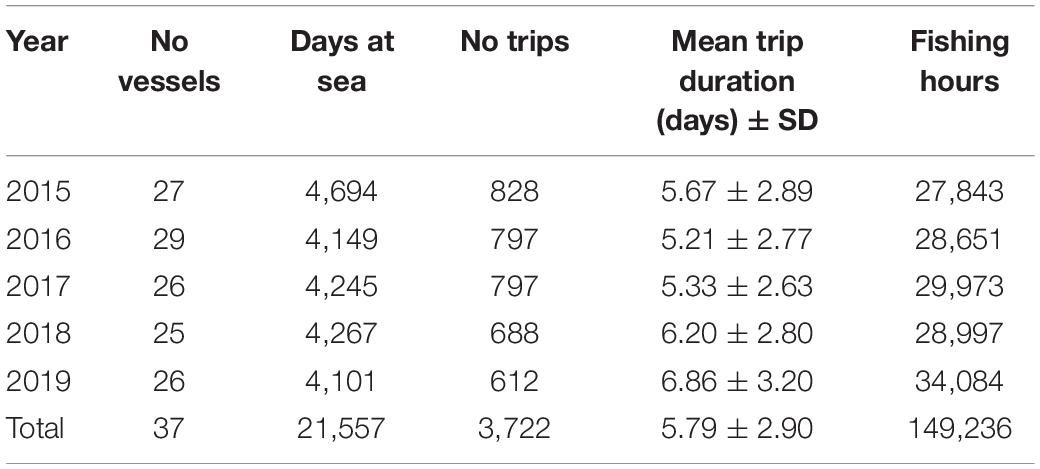
Table 1. Fleet capacity and effort allocation of the selected fleet obtained from logbook information and VMS analyses.
The logbooks are a compilation of individual vessels, fishing trips and fishing operations logged with unique ID and spatio-temporal information. Each fishing trip of an individual vessel performed during a certain year is registered with vessels features (length, tonnage, and engine power), starting date and harbor, landing date and harbor, and combined with a disaggregated fishing operations list. Each operation (haul) is cataloged with start-end time stamps, start-end coordinates, ICES statistical rectangle, gear, mesh size, landing catches, and prices per kilogram. Timestamps and latitude and longitude coordinates are informed by the VMS present onboard of every operating vessel above 12 m in length which continuously records the location of the fishing operation and the spatial coverage of the entire fishing trip. The information on total catches and revenues derived from each trip are collected at the sales auction after landing and are registered in sales slips merged with logbook events. Sale slips recorded each species weight (kg) and price (€/kg) landed at the end of each fishing trip. The data from the logbook and sales slips databases are available from the Danish Fishery Directorates web site as dynamic tables3.
We formed groups of 3 to 4 vessels with similar physical characteristics (e.g., vessel size and engine power) and similar fishing patterns and behavior for confidentiality reasons (Supplementary Table 1). The resulting grouping was used to describe the fishing units in all further analyses. Similarly the dataset was classified according to métier. The set of fishing activities were grouped into 9 métiers identified by the target species and the observed gears and mesh sizes (Table 2 and Supplementary Table 2). The trip métier and the target species are inferred from the dominant species landed in the logbook (Table 2). The métiers were used as units in all the analyses and comprise fisheries for industrial purposes and fisheries for human consumption.
The data from logbooks, sales slips, and VMS were combined in R (Bastardie et al., 2010; RStudio Team, 2020) to assess: (i) the temporal occupation of the Danish large vessel pelagic fleet in terms of fishing operations among seasons and years; (ii) the spatial coverage of the fleet activities among the ICES ecoregions; (iii) the effort allocation of the fleet in time and space; and (iv) the fishing patterns (métiers) and the catch composition of current Danish pelagic fisheries.
Methods for Economic Analyses
The sales slips gave incomes from landings per trip and prices per species. When the catches are destined for industrial processing, the landings are not sorted, and the same price per kilo is applied to any non-targeted landed species. When the catches are destined for consumption, prices per kilo are informed per species. We estimated the average catches per métier, and we considered the observed maximum catches per métier as a proxy for maximum vessel storage capacity. Fish price fluctuations over a 5 years period could be observed per species. Trip landing revenues were calculated from the product of the volume of catches and prices per species.
The EU STECF database provides the information on total yearly costs (fixed and variable costs) together with the fleet size and total trips and days at sea, although the information was not available for all. We considered the costs of demersal trawlers between 24 and 40 m, demersal trawlers above 40 m, and pelagic trawlers above 40 m, and assumed the costs of pelagic trawlers between 24 and 40 m to be similar to the demersal trawlers between 24 and 40 m and the purse seiners to have similar costs as the pelagic trawlers above 40 m. As a single cost estimate was available for any vessel above 40 m, a posthoc correction was applied to scale fixed and variable costs proportionally to the vessel lengths for all vessels > 40 m using simple linear regression models:
With linear regression parameters a–h being vessel specific. Fixed costs (i.e., costs that do not vary along the year or the effort deployed) cover the consumption of fixed capital, the repair and maintenance costs, the value of unpaid labor, and other non-variable costs. We evenly dispatched the annual fixed costs among trips to assume a fixed cost per trip. Variable costs are proportional to fishing effort and cover the payment of quotas, the energy consumption, the personnel costs, and other variable costs. We estimated the daily variable costs from the annual variable costs over the total number of days at sea. The same procedure was applied to fixed and variable sources of income which are not coming from landings. Following this, total costs, total revenues, and profits are expressed at the trip level as:
The BEP was estimated for each métier, except for the pilchard fishery (because the pelagic species is an occasional catch only) and the demersal mixed species fishery (whose target species are variable and do not fall in the intent of the study). The BEP represents the minimum revenue and catch per trip necessary to cover the trip-based costs and obtain a zero profit trip, corresponding to the crossing point of the revenue and cost regression functions (Figure 1A). The area for which each métier conducts a profitable fishery is deduced by projecting the BEP on the demand-supply trade-off graph (Figure 1B). Figures 1C,D show the theoretical BEP and profitability for a very profitable fishery, and Figures 1E,F show the theoretical BEP and profitability for a very costly fishery. The BEP may derive from an infinite combination of prices per kilo and harvested resources, but we expect that only a certain range of prices will be observed on the market in accordance with interview information. We also expect the volume of resources harvested during one trip to be limiting, lowering the possible profitable area. Hence, the BEP curve was obtained as follows:
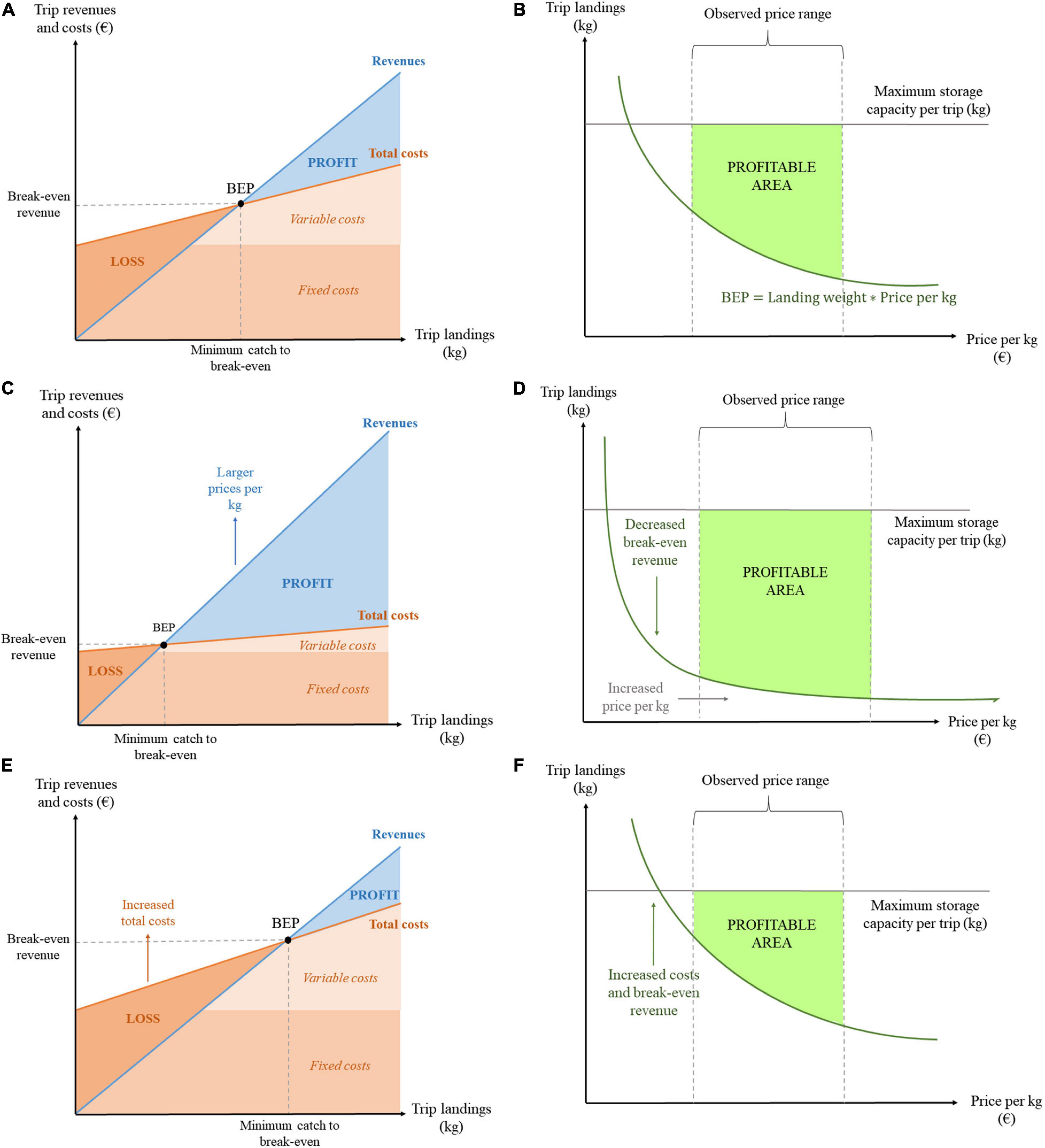
Figure 1. Graphical representation of the economic performances of a fishery. (A) Theoretical break-even point (BEP) derived from the intersection of revenues and costs functions over landing weight at the trip level. (B) Theoretical profitability identified as the area exceeding the break-even function and constrained by observed prices and storage capacity of the vessel. (C) Theoretical early break-even point (BEP) for the case of a very profitable fishery where revenues far exceed the costs. (D) Theoretical profitability of a very profitable fishery with a lower break-even function and a larger area of profit. (E) Theoretical break-even point (BEP) for a costly fishery with increased costs and limited profits. (F) Theoretical profitability of a costly fishery with a higher break-even point (BEP) and a shrunk area of profits.
Analysis of the Economic Performance of Potential Future Mesopelagic Fishery Based on Scenarios of Price, Cost, and Activity Dynamics
Sources of Information for the Analyses
To investigate the economic performance of a potential mesopelagic fishery, we developed and analyzed several future scenarios. We used the parametric dataset and analyses from the current Danish pelagic fleet described in section “Analysis of current Danish large vessel pelagic fleet and fisheries,” and supplemented this information with additional assumptions about the perceived changes and conditions necessary for a potential mesopelagic fishery. The mesopelagic scenarios and assumptions were based on interviews with the director and the chief scientific advisor of the DPPO, who are representatives of the Danish large vessel pelagic fleet. The DPPO represents 10 recently-built large pelagic trawlers out of the 37 selected pelagic vessels and purse seiners. The members of DPPO account for one-third of the Danish fish landing values, and hold the majority of the Danish quotas for key pelagic and industrial target species. On this basis, the DPPO is a valid representative of the Danish pelagic sector, and it has a well consolidated role with insight in the economy of the sector. The organization also represents a key potential investor into a mesopelagic fishery and the DPPO has explicitly expressed interest herein. The interviews followed a pre-prepared questionnaire which covered (1) the structure, the patterns and the behavior of the current fishing activities, and (2) the technical, economic and social challenges that the potential mesopelagic fishery would bring to the sector. A summary of the topics discussed can be found in the Supplementary Table 3. The questions were covering the following main topics:
• Current spatial coverage of pelagic fisheries, the maximum physical range covered within a trip and factors affecting trip duration.
• Current fishing depths, number of hauls, and achievable catch volumes.
• Current storage, processing, conservation methods, and capacity on board.
• Reasons for the investment in or switching to mesopelagic fishery.
• Perceived drivers of fishing patterns, spatial coverage, and catches of a mesopelagic fishery (e.g., distance to fishing grounds, behavior and conservation of target species, market demands, and prices).
• Fishing depths, number of hauls per day, maximum achievable volume per haul, and minimum needed catch for the profitability of a new mesopelagic fishery.
• Expected prices per kg of mesopelagic resources given conservation methods and comparison with possible similar fisheries.
• Cost structure of a mesopelagic fishery, including additional costs due to fuel consumption changes, gear adaptations, storage, processing and conservation changes, in comparison to possible similar current fisheries.
Methods and Parameters for Economic Analyses
We built potential profitability scenarios for mesopelagic fisheries, informed and constrained by fishermen perception of potential mesopelagic fishery fishing costs, fish prices, maximum catches achievable per trip and trip feasible durations dependent on the conservation method adequate for mesopelagic species. The average minimum landing per trip necessary to break-even was estimated from the intersection of the BEP revenue curve and the range of price selected. We investigated three BEP values that represent the minimum, the average and the maximum BEPs that were observed as the range among the current pelagic fisheries analyses; the smallest BEP represents the current sprat fishery; the intermediate BEP represents the current herring fishery for human consumption; and the highest BEP represents the current blue whiting fishery. The mesopelagic fishing costs were perceived similar to the current blue whiting fishery (the fishery with the highest BEP observed), but two scenarios were added to account for the range of BEPs estimated for the current large scale pelagic fisheries. Because the cost structure of the new fishery is unknown we forecasted a 50% increase and a 100% increase in both fixed and variable costs from the baseline scenarios within perceived realistic ranges of fish prices and landing amounts. Further details on the economic analyses are given in section “Outcomes from the interviews with representatives from the DPPO.”
Results
Evaluation of Current Danish Large Vessel Pelagic Fisheries and Fleets
Fishing Patterns, Activity Levels and Behavior
All vessels in the different vessel groups are highly occupied all year round during the 5 year period (2015–2019; Figure 2A). Main fisheries in the pelagic sector according to yearly occupation are sprat and herring fisheries (Figure 2B) which are performed all year round differently from the other fisheries that have strong seasonal patterns and are undertaken in specific quarters of the year. The largest vessels of the selection are grouped in Group 1, 2, and 3, and are extensively involved in herring fishery, interspersed with blue whiting fishery, horse mackerel fishery, and Atlantic mackerel fishery, which are not performed by any of the smaller vessels. Most of the other vessels displayed a seasonal alternation among sandeel fishery, sprat fishery and Norway pout fishery. Only the smallest vessels of the selection engaged in some demersal mixed species fishery in alternation with pelagic fisheries. The yearly, seasonal and geographical patterns in the behavior of the different groups are described below.
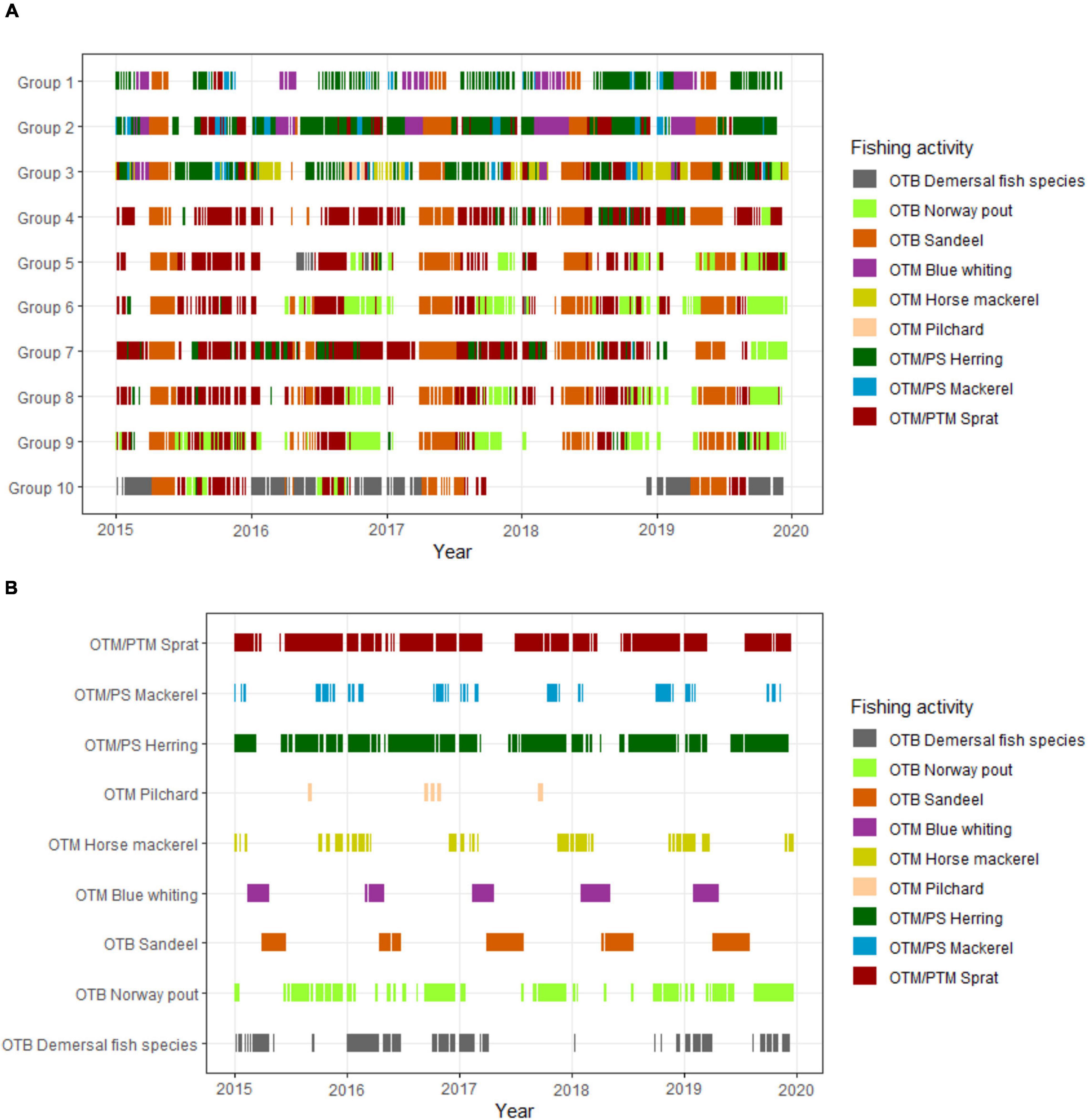
Figure 2. Timeline of fishing activities along 5 years period of time (2015–2019). (A) Temporal distribution of fishing trips among vessel groups by métier. (B) Temporal distribution of fishing operations (haul-to-haul basis) by métier.
Trip Duration and Seasonality
A range of trip duration from 1 to 16 days and maximum trip length between 13 and 16 days were observed among all métiers during 2015–2019. Specific mean trip durations were highlighted by métier (Figure 3). Among the métiers using bottom trawl gears the sandeel fishery had an average trip duration of 7 days, the Norway pout fishery had an average trip duration of 8 days, and the demersal fish species fishery had an average trip duration of 4 days. Among the métiers using mid-water trawls for industrial purposes, an average trip duration of 6 and 8 days was found for the sprat and the blue whiting fishery. Among the métiers for consumption purposes, average trip durations of four, 4, 10, and 5 days were observed for the Atlantic mackerel, the horse mackerel, the pilchard and the herring fisheries, respectively. However, the trip duration was mainly dependent on catches and storage capacity (Figure 3A).
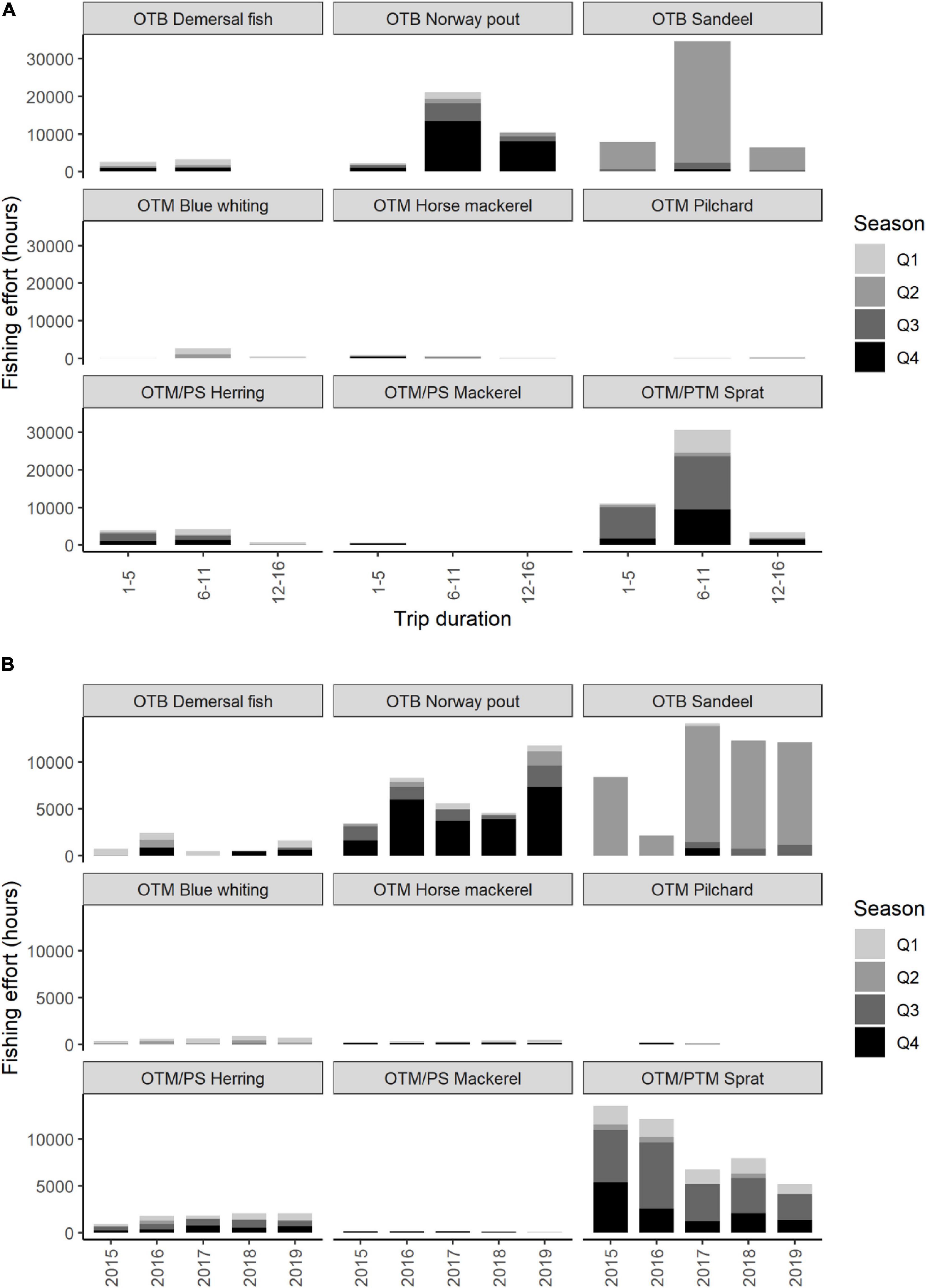
Figure 3. Fishing effort allocation among vessel groups by métier with (A) fishing effort as fishing hours among quarters and years by métier during the period 2015–2019, and (B) seasonal allocation of fishing hours by trip duration intervals in days.
When looking at the distribution of trip durations per métier, 86% of the time, fishing for blue whiting was during trips lasting 6–11 days. Furthermore 89% of the time fishing for Atlantic mackerel was at trip durations below 5 days, and 70% of the time, fishing for pilchard was during trips longer than 13 days. Similarly, 60% of the herring fishery was emplaced in trips less than 6 days, and 60% of the time, fishing for horse mackerel was during trips less than 5 days. In the sandeel fishery 63% of the effort was emplaced in trips between 6 and 12 days. The sprat and the Norway pout fishery had the fishing effort distributed over two-thirds of the trip duration range, with 94% of the sprat trips between 1 and 12 days, and 89% of the Norway pout trips between 6 and 16 days long. Finally, the demersal fish species fishery had fishing effort distributed evenly in trips no longer than 11 days.
Fishing for Norway pout, sandeel and blue whiting constituted seasonal distinct fisheries as shown by the seasonal allocation of the fishing hours (Figure 3B). The Norway pout fishery was mainly conducted in the fourth quarter of the year while the sandeel fishery was designated to the second quarter of the year where the sandeel fishery typically is associated to the sandeel feeding period. Sprat and herring were harvested all year round, less extensively during the second quarter of the year. Both blue whiting and horse mackerel were targeted during the first quarter of the year, while Atlantic mackerel is mainly harvested during the fourth quarter of the year. Fishing effort distribution by ICES ecoregion is displayed in the Supplementary Figure 3.
Spatial Fishing Patterns
The spatial coverage in the North East Atlantic of the Danish large vessel pelagic fleet is quite widespread and the full, extensive geographical coverage expressed as haul observations per vessel group and fishing effort distribution expressed in fishing hours are shown in the Supplementary Figures 1, 2. The geographical distribution of the métiers in main sea areas by vessel group is shown in Figure 4. The majority of the activities took place within the Greater North Sea area and the Baltic Sea. However, the three largest vessel groups regularly engaged in fisheries that took place in distant ICES regions such as the Norwegian Sea, the Celtic Sea and the West of Scotland sea, and sometimes down to the Bay of Biscay (Figure 4). The geographical distribution of the métiers and their concentration in specific quarters of the year are to a large extent driven by distribution and densities of the targeted species (Figure 5), but also by access to third country EEZs and specific geographical regulations, i.e., closures such as the sprat box (ICES, 2020a,b) and the Norway pout box (Bigné et al., 2019). The blue whiting fishery, the horse mackerel fishery and the Atlantic mackerel fishery were located furthest away and were consequently undertaken only by the three largest vessel groups.
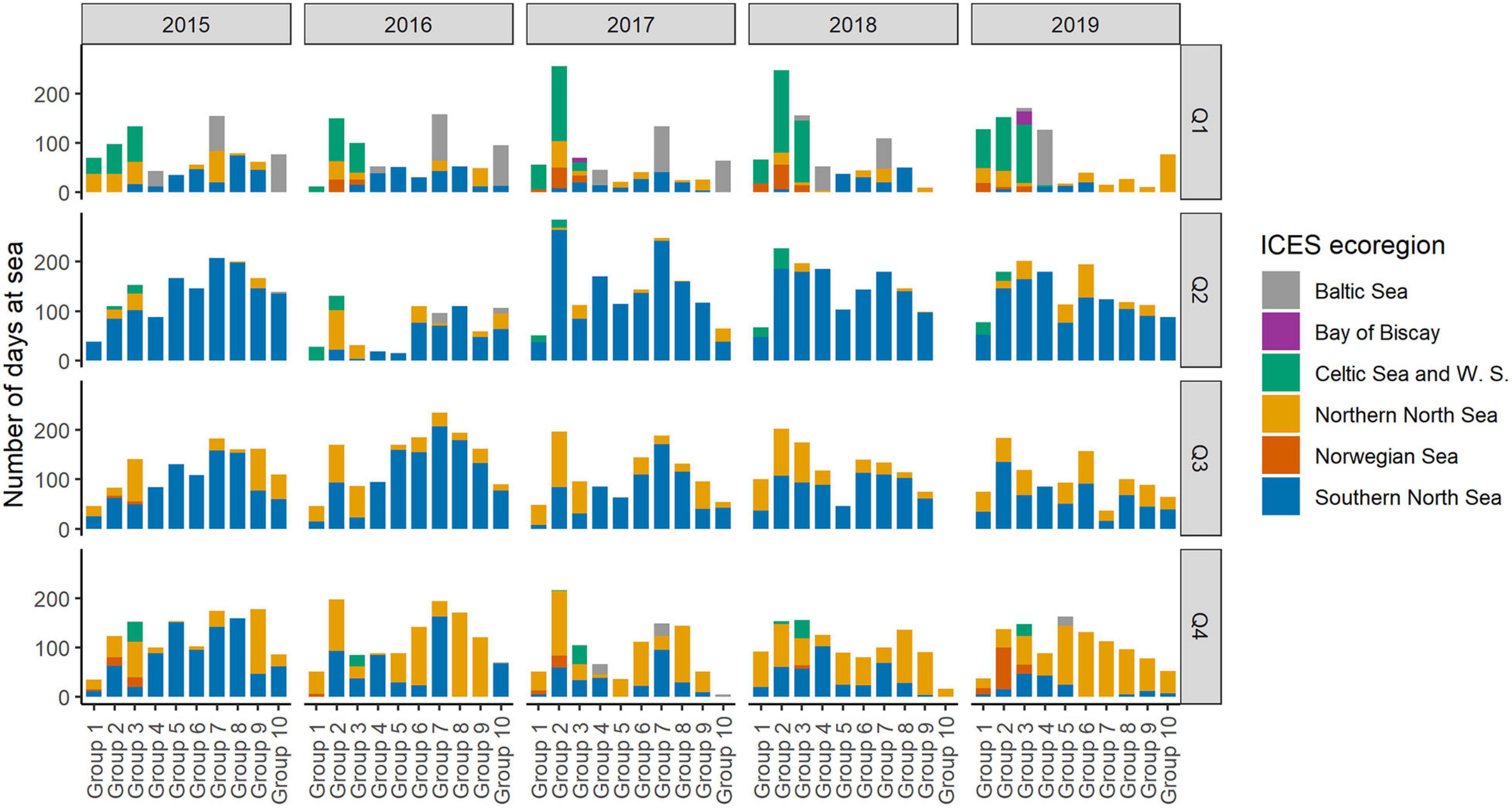
Figure 4. Days spent at sea by each vessel group among quarters and years, distinguished by the ICES ecoregion they were spent in during the period 2015–2019. The vessel groups are detailed in Supplementary Table 1.
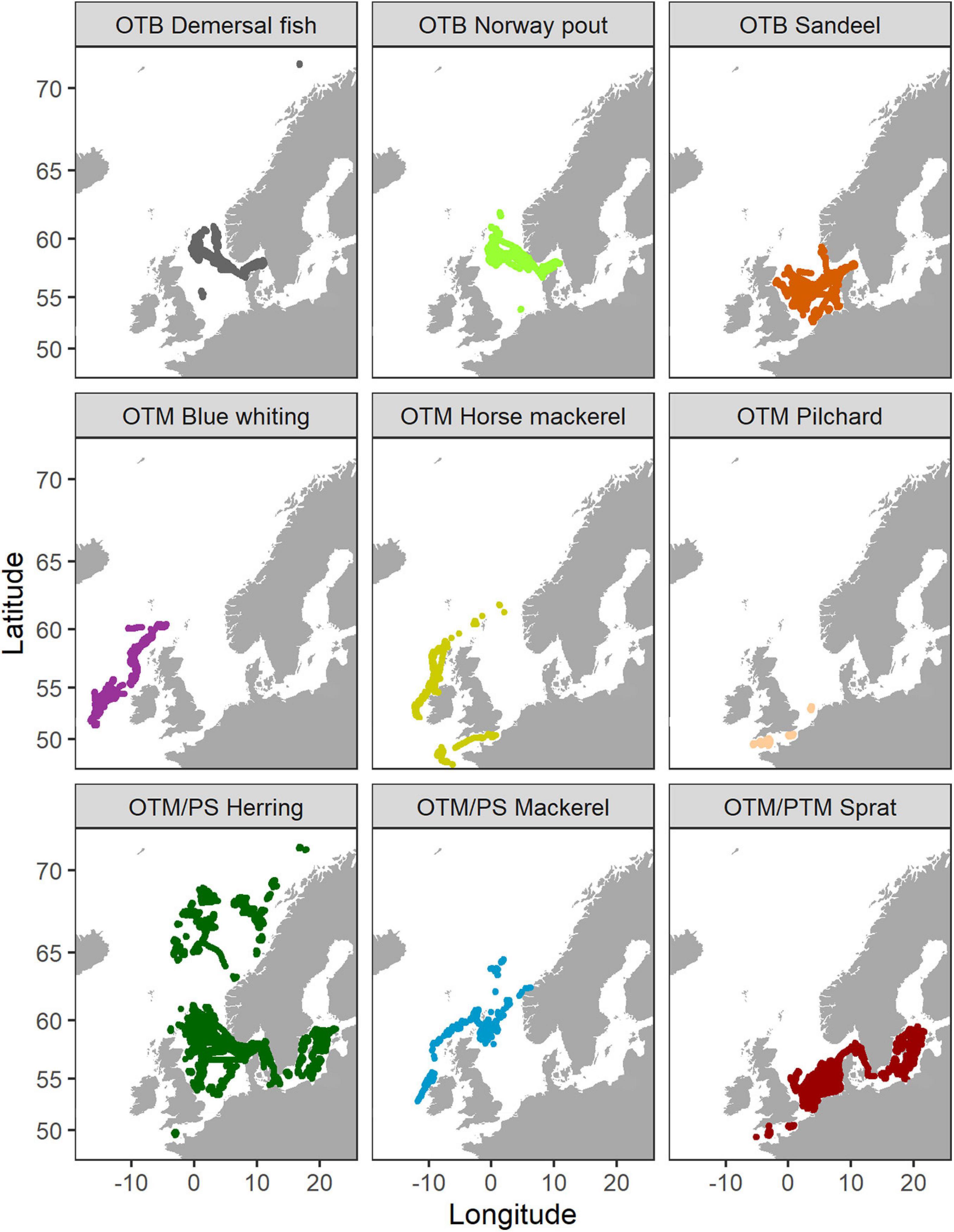
Figure 5. Geographical distribution of VMS points indicating fishing operations by métier along the North East Atlantic during the period 2015–2019 for the Danish large pelagic vessel catch sector.
Species Targeting and Catch Composition
The relative species composition in the catch derived from landings and sales slips for each of the métier performed by the Danish large vessels pelagic fleet is shown in Figure 6 for the period 2015–2019. Besides the demersal mix species métier which targets multiple species, the other métiers had catch compositions dominated by the single target species, except for the sprat and herring fisheries which showed mixed catches of herring and sprat, respectively. Another noticeable mixed fishery and by-catch percentage was within the horse mackerel fishery which often harvested Atlantic mackerel and other collateral species (mainly boarfish; Caproidae).
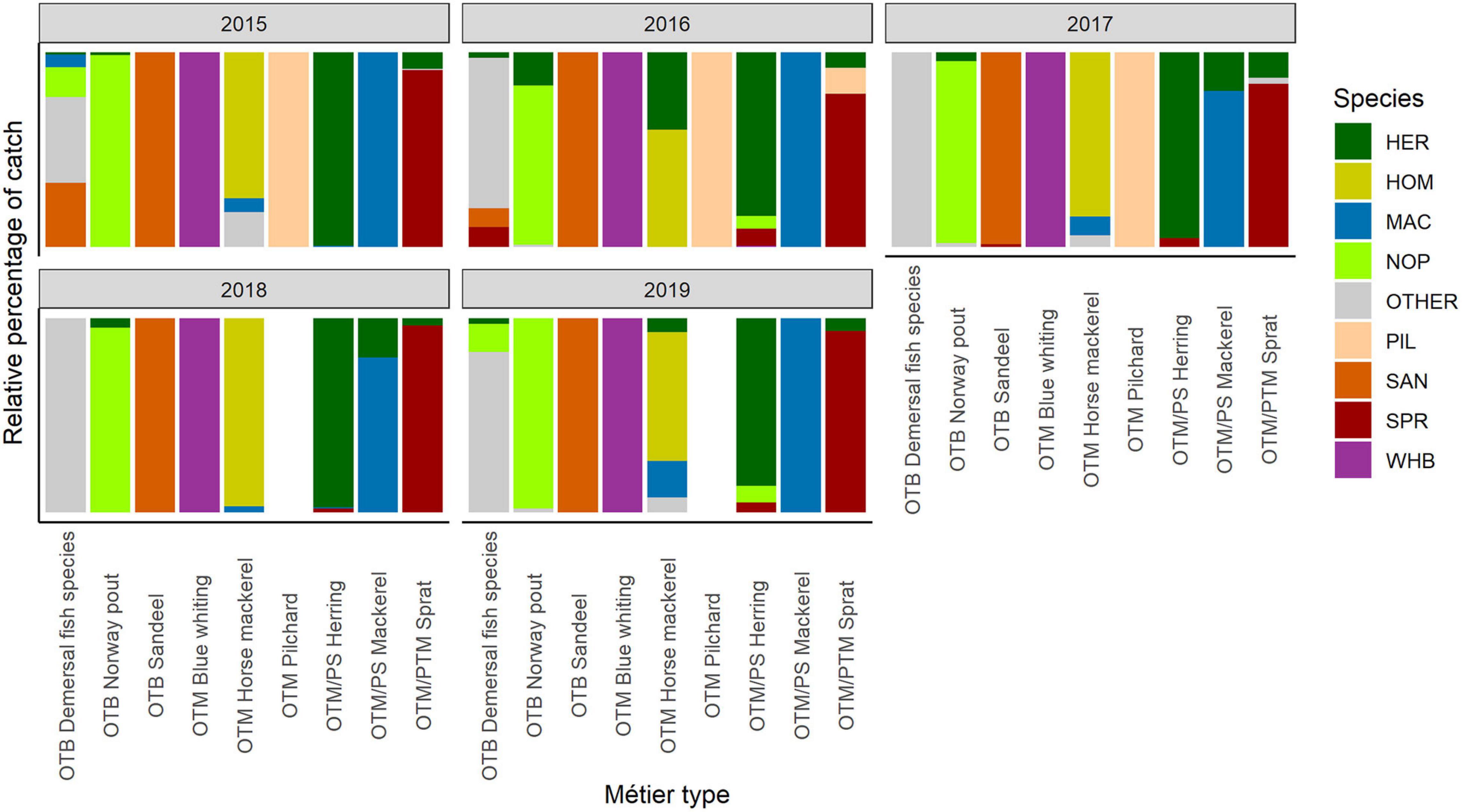
Figure 6. Relative species composition in the catch of each métier by year during the period 2015–2019, distinguishing main targeted species from other collateral species.
Economic Dynamics and Performance in Current Pelagic Fisheries
The analyses of the sales slips displayed that the dominant species in landing weight were sprat, herring, and sandeel (Figure 7A). However, different market prices make herring, Atlantic mackerel and sprat the most important harvested species in terms of landing revenues (Figure 7B). The comparison of catches and revenues among the 5 years period of time (2015–2019) revealed a certain price fluctuation over the years for most of the species which indirectly appears from Figure 7 as well. According to the insights from the DPPO interviews (see also section “Evaluation of economic performance of potential future mesopelagic fishery”) the price fluctuations for industrial species relate mainly to fluctuations in world market demands and price variability for soya beans, another resource for livestock feed (Rana et al., 2009).
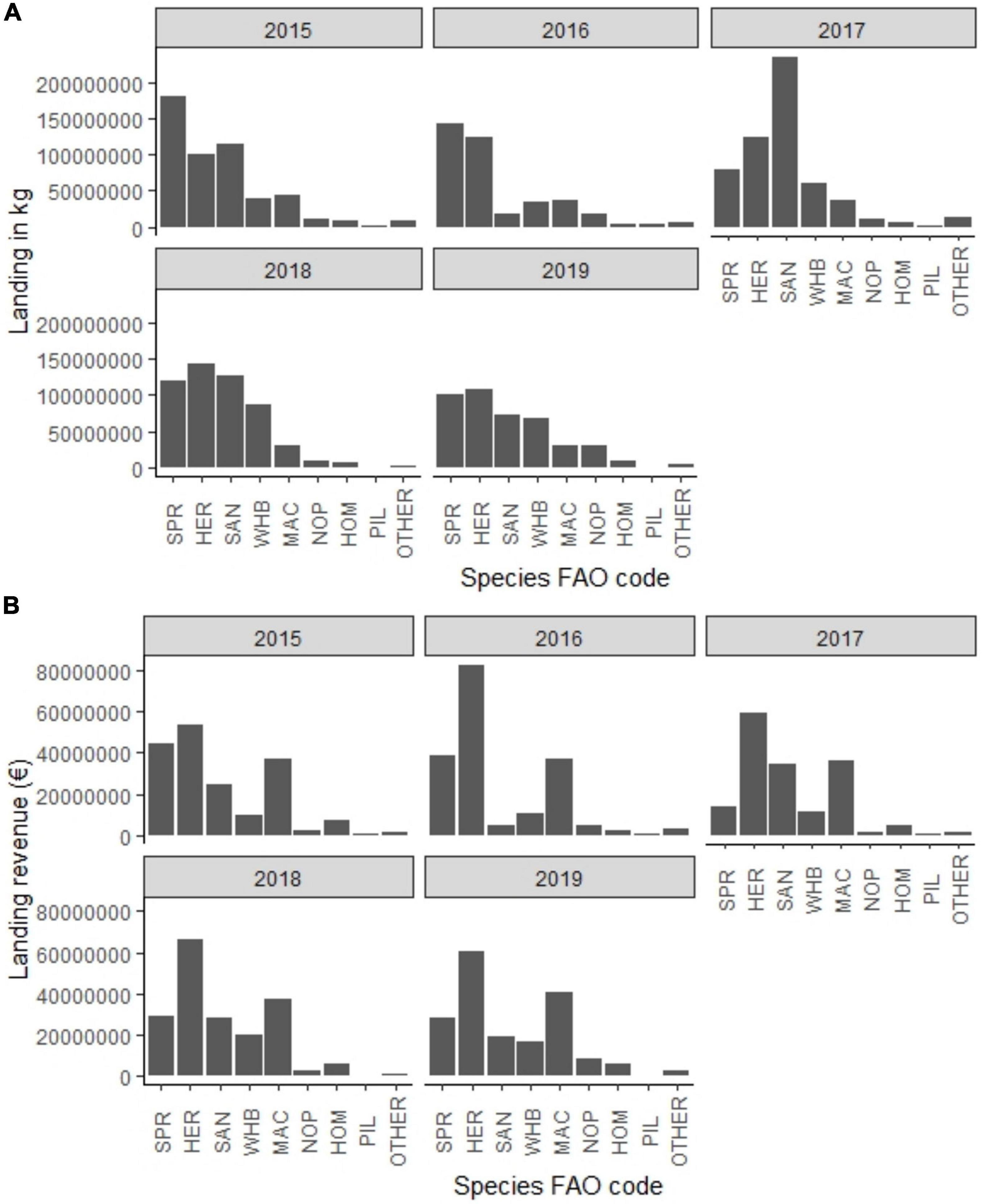
Figure 7. (A) Total landing weight and (B) Total landing income from landings by targeted species in recent years from 2015 to 2019. The yearly relative differences between the two panels reveal price variability.
The fishing trip BEP, defined as the minimum revenue to break-even the cost, was estimated for each métier from the intersection point of the revenue and cost linear functions within each métier (Figure 8). Linear regressions between costs, revenues and landings were made for different resolutions of vessel categories selecting the top three represented vessel groupings by trip number in Figure 8. The specific BEP estimates for size classes (vessel lengths) and estimates of average trip BEP by métier are shown in the Supplementary Table 4, specific BEP estimates for different vessel groups and years are given in the Supplementary Tables 5, 6. A strong linear proportionality between the BEP and the size of the vessel was demonstrated with high correlation coefficient (Supplementary Figure 4). This positive vessel size dependency in the BEP also appears by métier (Supplementary Table 4).
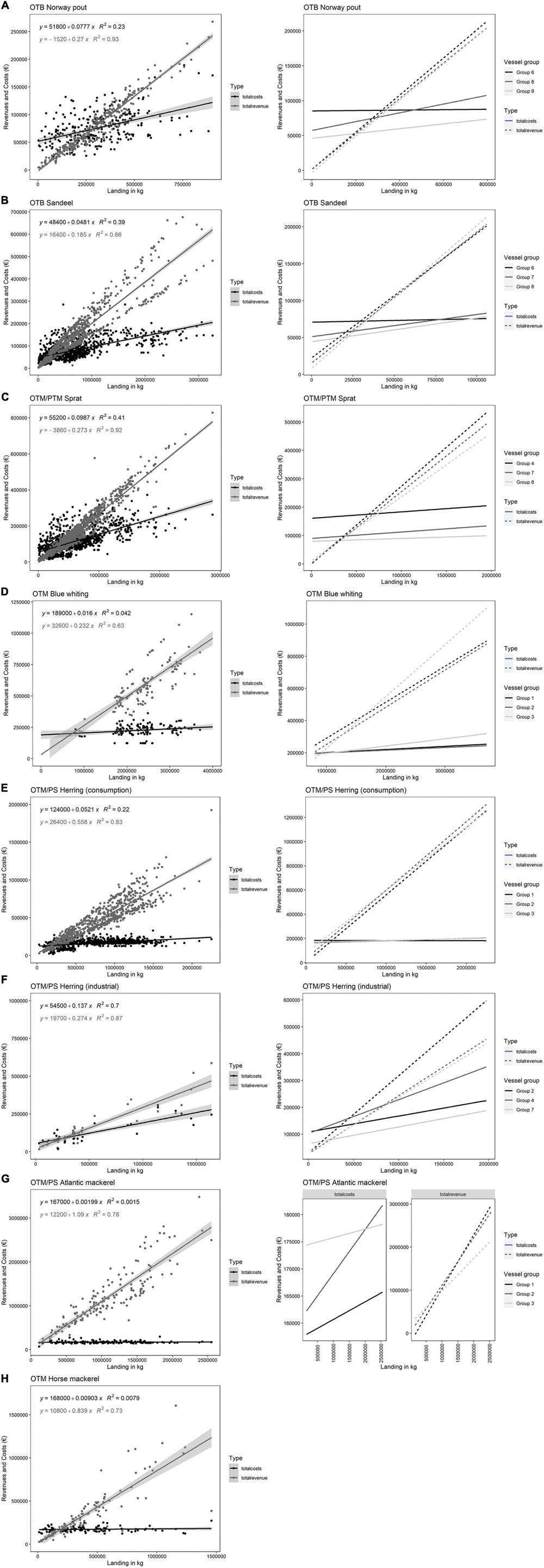
Figure 8. BEP graphs by métier for the Danish large vessel catch sector with (A) OTM Norway pout, (B) OTB Sandeel, (C) OTM/PTM Sprat, (D) OTM Blue whiting, (E) OTM/PS Herring (consumption), (F) OTM/PS Herring (industrial), (G) OTM/PS Atlantic mackerel, and (H) OTM Horse mackerel, for the period 2015–2019.
As both fixed and variable costs increase with vessel size and catch volume, the net profit showed more variability across size classes. The total estimated profit over the selected 5-year period indicated that the métiers targeting herring and Atlantic mackerel for consumption were the most profitable in the Danish large vessel pelagic catch sector. The métiers targeting sprat, sandeel, and blue whiting displayed similar profitabilities, however, the Norway pout fishery was indicated as only a marginally profitable métier.
The demand-supply graph highlights the estimated profitable area for each métier (Figure 9). The shape and the distance to the origin of the trade-off curve between catches (kg) and prices (€/kg) determine the size and shape of the profitable area, and hence the profitability of the given métier. The trip catches and prices are averaged per métier over the 5-year period (2015–2019). Prices of target species vary both between seasons and years and is included in the vertical price range limit per métier in the graph. The observed prices vary according to the landing site, the processing plant, the quality of the catch and their oil/fat content. Larger scale price variability is also driven by demand of fish meal and soybeans and world market prices in general. The economy portrayed for each métier were in accordance with what observed in the BEP graphs (Figure 8). Average catches well above the trade-off curve generate revenues above the break-even value by trip and are linked to métiers that have positive net profit for every trip undertaken. This was observed especially for the blue whiting and the Atlantic mackerel fisheries. On the other hand, average catches closer to the trade-off curve lead to zero profit trips and to a smaller overall net profit as was observed for the Norway pout fishery.
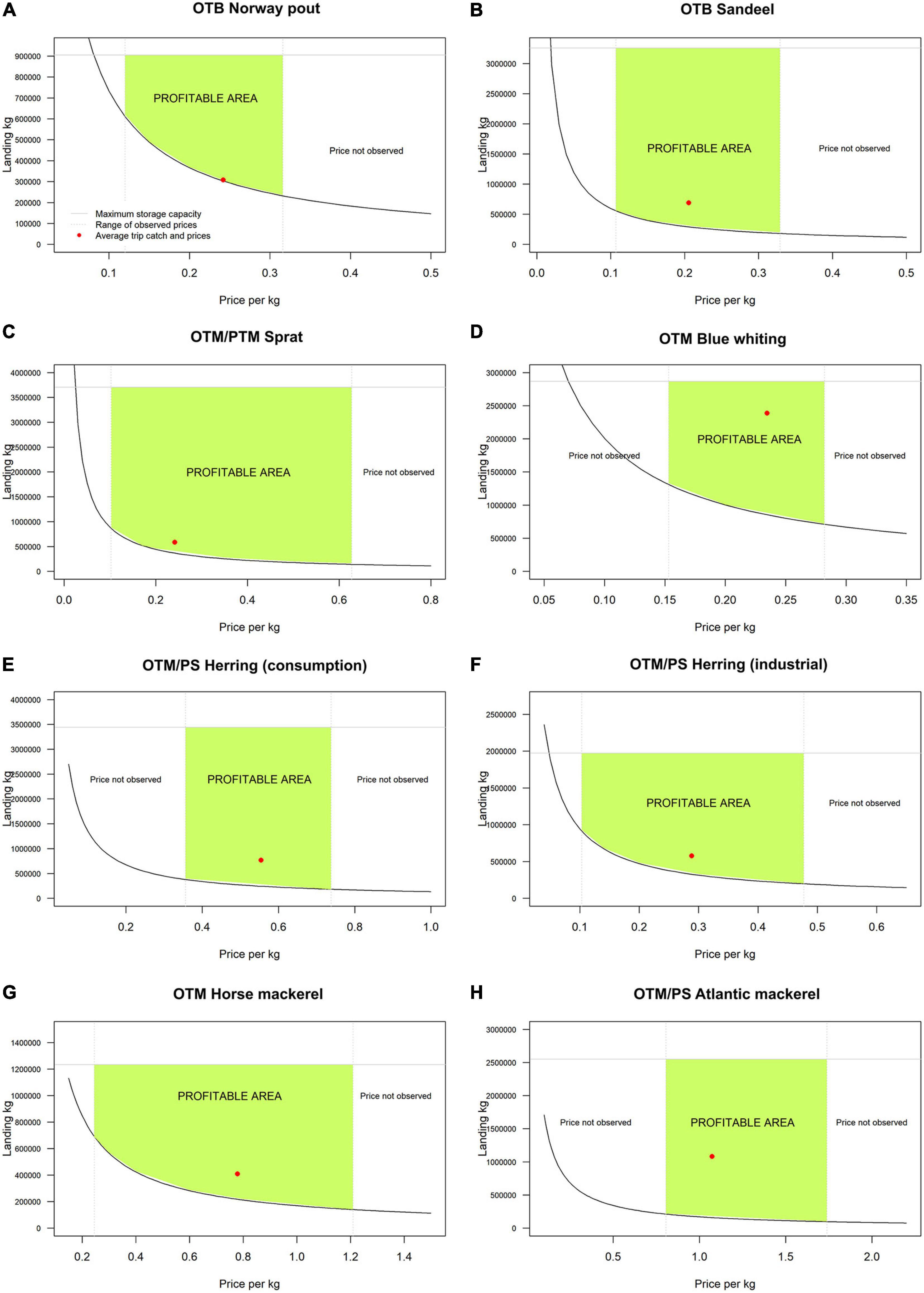
Figure 9. Potential profitability of main pelagic métiers for the Danish large vessel pelagic catch sector during the period 2015–2019 delimited by the bio-economic variables, with (A) OTB Norway pout, (B) OTB Sandeel, (C) OTM/PTM Sprat, (D) OTM Blue whiting, (E) OTM/PS Herring (consumption), (F) OTM/PS Herring (industrial), (G) OTM Horse mackerel, and (H) OTM/PS Atlantic mackerel.
Evaluation of Economic Performance of Potential Future Mesopelagic Fishery
Outcomes From the Interviews With Representatives From the DPPO
The interviews provided insights, perspectives, and factual economic information into which will be the main challenges, factors, and incentives influencing the potential switching to or the initiation of new mesopelagic fishery activities for the Danish large vessel pelagic fleet. The difference in fishing effort (days spent fishing) among current pelagic métiers that we observed above were explained as being linked to the targeted species distribution and its conservation possibilities. Potential mesopelagic fisheries will likely be performed by the métiers that make fishing trips of approximately five fishing days. The interviewees informed that exploratory trips in distant areas (e.g., up to East Greenland or along the African coasts) can occasionally and will likely occur.
The DPPO representatives indicated that mesopelagic resources are particularly interesting because of their perceived relatively high fatty contents, which has been supported by experiences from previous Norwegian and Icelandic experimental fisheries for Maurolicius muelleri. By experience, the prices will increase with higher relative fat content of the resources (Rana et al., 2009). Landing prices will likely be similar to summer herring prices landed for industrial purposes because of a similar fat content, and hence would head toward the upper end of the current observed prices range for pelagic fish resources used for industrial purposes between 3.5 and 6 NOK/kg (corresponding to 0.30–0.55 €/kg). The price depends not only on the total high oil content and relative amount of lipids in the resources, but also upon the composition of the fatty acids (omega three acids) which will determine the price for fish meal and fish oil. In 2019–2020, prices in Norway have been between 3.5 and 4.5 NOK (corresponding to 0.30–0.40 €) for landed Maurolicus in trial fisheries which is better paid than blue whiting also used for meal and oil production. Such economically interesting resources with high fat content will according to the fishers inevitably bring new opportunities and challenges. None of the selected vessels currently owns any parts of or in the fish processing industry, neither for the purpose of consumption not fish mean/oil production. Thus, there is no ownership or membership that could influence the behavior of the fishery sector and its willingness to invest into a potential mesopelagic fishery, even at a lower expected profit. The DPPO representatives expressed that the behavior observed in the current pelagic fisheries and the willingness to invest into a new activity are driven by its biological sustainability and profitability within the catch sector.
Conservation is, however, a main issue. With the current conservation method (RSW), the trips where the duration between the day of first catch and the first landing needs realistically to be 3–5 days before losing significant quality of the stored resources on board. This observation is also supported by experiences from previous Norwegian and Icelandic experimental fisheries for Maurolicius. That is the period from the first catch being taken on board to the actual landing in harbor. Trips with longer steaming time and shorter concentrated fishing time are possible, but once the first catch is stored it will need to be landed within 3–5 days when using refrigerated sea water (RSW), which is the dominating conservation method on board in current fishery. In accordance with the literature results given in the introduction, the interviews also put emphasis on that the conservation method is inversely proportional to the fat content of the targeted species. If the method is improved to conserve species with high fat content, e.g., freezing, or the vessel adds, e.g., a fish meal processing facility on board, the fishing trip duration may be increased and become comparable to other current pelagic fisheries. Among new conservation methods the silage production, freezing, acids, thermic separation, and enzymatic hydrolysis may be considered. Consequently, the trip duration is not only dependent on the storage capacity, but also on the concentrations (densities) of the resources in relation to the fishing capacity, i.e., needed fishing time to fill the storage, but also on the distance between the fishing areas and landing harbors with necessary processing facilities determining the needed steaming time for landing in relation to a trade-off in quality – and accordingly prices – of the catch. Currently all ten large pelagic vessels organized by the DPPO have RSW systems on board where species are cooled down and maintained in sea water between 0 and −1 degrees to preserve the best quality. The storage capacity depends on the vessel length, where currently the largest pelagic vessels store up to 3,000 tons per trip. Landings by the DPPO occur both in national and foreign harbors, including Norway, Scotland, the Faroe Islands, and Germany besides Denmark.
From the interviews it appeared that fishing patterns and trip cost structure would mostly resemble the blue whiting fishery among the current large pelagic vessel fisheries which is also a small meshed deep sea trawl fishery. As such, it would be a relatively heavy fishery, fishing at large depths that require high fuel consumption and extensive engine power due to the large, small meshed trawl gears hauled and filtering large water masses through fine mesh sizes, as well as heavy weight gear from among other the long wires used. However, no avoidance reaction to the fishing gear is expected by mesopelagic species contrary to traditional blue whiting fishery. The interviews confirmed that schooling species are targeted with shorter duration but more frequent fishing operations, where the fishermen skills and expertise come extensively into force (e.g., the blue whiting fishery), while non-aggregating species were targeted with longer duration hauls deployed fewer times (e.g., the Norway pout fishery). Mesopelagic species undergo a diel vertical migration as observed by the DPPO at sonars and echosounders at around dawn and dusk, which vertical migration patterns are also supported by literature (Ishihara and Kubota, 1997; Sutton et al., 2008; Hudson et al., 2014). A fishing pattern conducted by two long tows per 24 h diurnal period will likely be most efficient to target species with such diurnal migration. That is, 1 day haul and one night haul, and then heaving and setting at dusk and dawn when the resources are migrating and changing depth distribution. According to the DPPO perception, then catch amounts per tow will most likely resemble the sandeel fishery, with tow weights typically ranging between 200 and 500 tons per haul.
Based on the interviews, additional costs could not be quantified precisely before further investigation in the DPPO databases was conducted, but according to the DPPO it would surely include the development of new gears and storage facilities. With respect to new gear, it would be central to find the right relative proportion of mesh sizes of the different panels down through the trawl to the very fine mesh sizes in the cod end in order to increase catch and reduce fuel costs. That is, to increase catch rates according to fish behavior and at the same time reduce fuel costs by not pushing unnecessary much water by the trawl, i.e., to reduce the water resistance. Under all circumstances there will be an increased fuel consumption compared to the current small meshed pelagic fisheries for industrial purposes conducted by the DPPO. Investments in the construction of a new vessel were also considered very realistic by the DPPO also considering the current activity levels of the existing fleet and in order to quickly establish historical fishing rights according to future quota allocation. This should according to the DPPO certainly be considered in relation to the fishery break-even and profitability considerations.
Economic Performance of Potential Mesopelagic Fishery Integrated From Current Fishery Analyses and Outcomes From the Interviews With Representatives of the DPPO
Potential profitability scenarios by trip for mesopelagic fisheries were developed given the information obtained from the interviews (Figure 10). The first row of scenarios was established using approximations of the smallest (sprat fishery; ∼90,000 €), the intermediate (herring fishery for consumption; ∼150,000 €), and the largest (blue whiting fishery; ∼200,000 €) BEP revenues estimated among the current strictly pelagic fisheries and represent a realistic range for potential mesopelagic fisheries. Current observed price ranges of 3.5–6 NOK/kg (0.30–0.55 €/kg) for pelagic resources as explained above vertically delimited the profitable areas, while the maximum expected catch per trip as perceived by the DPPO delimited the areas horizontally. The maximum expected catch per trip was estimated as follows:
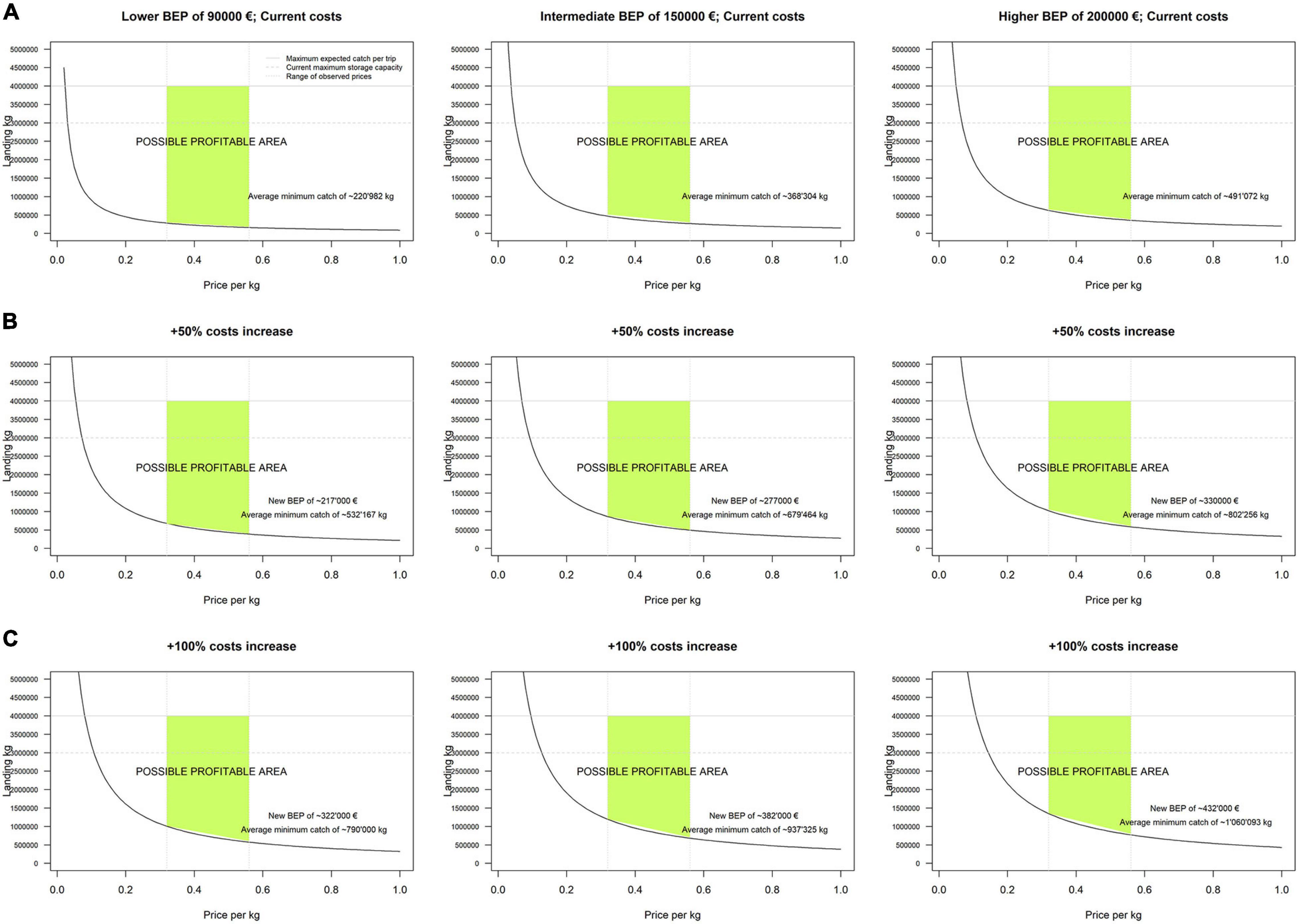
Figure 10. Potential profitability scenarios by trip for mesopelagic fisheries as perceived from current Danish large vessel pelagic fish sector activities and results from interview investigations of the DPPO representing this catch sector. Dotted lines indicated the current maximum storage capacity, solid lines indicate realistic future storage capacity, e.g., new vessels. (A) Different BEP scenarios were chosen to build the trade-off curves and display the corresponding profitable areas under current costs similar to the blue whiting fishery. (B) BEP and profitability changes under costs scenarios increased by 50%. (C) BEP and profitability changes under costs scenarios increased by 100%.
where realistic indications according to current conservation and storage possibilities were considered 500 tons of maximum expected catch weight per tow, two number of tows per day, and four effective fishing days, for a maximum expected catch per trip of 4,000 tons. Two other rows of scenarios displayed the changes in BEPs and profitability when, respectively, a 50% and a 100% increase in both fixed and variable costs are considered (estimated) from the cost-structure of the perceived most similar current pelagic fishery, i.e., the blue whiting fishery.
The break-even revenues gradually increased given increasing total costs (Figure 10) because of the lifting and steepening of the cost function in relation to the revenue. The increase in the break-even revenue lifts the demand and supply curve from the origin and drives the shrinking of the potentially profitable areas. For all scenarios developed, the results indicate a maximum profit between 1,560,000 and 1,208,000 euro (€) per trip given current maximum storage capacity of 3,000 tons for a trip of 3–5 days (limit set by the dotted line) but may be higher if the storage capacity is improved and the catches are maximized to 4,000 tons per trip (limit set by the solid line). The range of maximum potential profits can be estimated as the maximum potential revenue of 1,650,000 € (right corner at the limit set by the dotted line) subtracted of each scenario specific BEP. Within a trip the range of minimum catches to break-even goes from an average of 220,982 kg (average of the bottom corners of green area in the first panel) to 1,060,093 kg (average of the bottom corners of green area in the last panel). The highest break-even revenue forecasted is 432,000 € (last panel).
Discussion and Perspectives
In this study, detailed information of fishing effort, catches, revenues, and costs of vessels and métiers of the Danish large vessel pelagic fleet over the period 2015–2019 were investigated and integrated with information and perspectives from interviews with key stakeholders. Interviews with main representatives of the DPPO, including the director and their chief scientific advisor that represent an important part of Danish pelagic fishing vessel owners, gave insights into necessary changes, potential revenues, and additional costs in a potential mesopelagic fishery. Based on this information we have analyzed the current fishing dynamics, providing new insights into the pelagic fisheries at national level, and into the economic conditions and incentives related to the development and investment into a new potential mesopelagic fishery in the North East Atlantic.
The majority of the activities of the Danish pelagic fishery takes place within the Greater North Sea and the Baltic Sea. However, large vessels also engaged in fisheries in more distant areas such as the Norwegian Sea, the Celtic Sea and the West of Scotland sea. Most métiers mainly focused on one single target species. Exceptions are the demersal mix species métier which targets multiple species, the sprat and herring fisheries and the horse mackerel fishery, which often also harvested Atlantic mackerel and other collateral species.
The initiation of a new fishery will most likely require switching from on-going fisheries and activity patterns or need for fleet expansion, since the temporal distribution of the fishing activities of the current Danish pelagic fishery showed that each vessel group is managed and organized to be fully active and occupied year round for all vessel groups. Seasonal métiers are currently alternated, and reveal no major gaps in the fishing activities performed by the full fleet capacity. Accordingly, we cannot reject our zero hypothesis that the large pelagic vessel fleet does not have time available and is fully occupied to perform additional mesopelagic fishery without switching from other current métiers.
We evaluated the economic efficiency and sustainability of the current métiers based on economic BEPs and profitability (Prellezo, 2019), to investigate the switching possibilities in more detail. The Norway pout fishery showed the smallest window of profitability and estimated net profits, likely due to high costs because of long distance fishing grounds and long hauling times, and should be considered when contemplating potential switching from existing activities. The high average trip catches and prices in the Atlantic mackerel, blue whiting, herring and sandeel métiers results in larger windows of possible profitability which may generate economic possibilities for new investments into new vessels, equipment and processing facilities. According to those results we cannot reject the zero hypotheses that all current pelagic fisheries exemplified by the Danish large vessels pelagic fleet are economically efficient and would not have incentives to switch to mesopelagic fishery. In the Norway pout fishery for some trips the costs were higher than revenues, resulting in a negative net profit. However, over the entire time frame the Norway Pout fishery is still profitable when all the trips are summed up.
The interviews indicated that the potential revenues and costs associated to fishing trips targeting mesopelagic resources would likely not differ extensively from the current economics observed for ongoing pelagic métiers. They were specifically foreseeing similarities between the current herring fishery for industrial purposes and the potential mesopelagic fishery in terms of revenues because of the relative high lipid/fatty acid contents of the mesopelagic resources, with a similar order of magnitude as summer herring (Phleger et al., 1999; Lea et al., 2002; Hamre et al., 2003; El-Mowafi et al., 2010; Koizumi et al., 2014).
Fishing costs will likely be similar to the current blue whiting fishery as this is also a mesopelagic resource and is fished with large small-meshed trawls. However, considerable additional costs might arise with needed vessel modifications or investment into new vessels to conduct an efficient mesopelagic fishery. These modifications include storing capacity, conservation and processing methods, as well as changed fishing gear. Sustainable trawling praxis and methods have to be developed to conduct both deep fishing (day fishing) and shallow fishing (night fishing) according to the vertical distribution patterns of mesopelagic species (Grimaldo et al., 2020) and sustainable herding mechanisms to improve the catch rates and to reduce by-catches. New trawls and fishing methods will be developed to ensure the methods are applicable to a larger fleet and to reduce the energy consumption and costs during mesopelagic trawling in relation to drag resistance of the small meshed fishing gears (trawl cod-end mesh size <10 mm; Valinassab et al., 2007; Lamhauge et al., 2008; Eigaard et al., 2012; Sebastine et al., 2013; Trenkel et al., 2013; Grimaldo et al., 2020). This is much smaller than for typical trawls used in the current small meshed pelagic fishery for industrial purposes (Eigaard et al., 2012; Bigné et al., 2019). Furthermore, trawl design and fishing methods will adapt in relation to species-specific behavior of target species and their response to herding methods (Grimaldo et al., 2018, 2020). With respect to the latter different frequencies and intensities of light and ultrasound could also be considered as alternative herding methods for concentrating mesopelagic fish. Also, introduction of continuous cod-end pumping systems to minimize trawl setting and heaving time and operations could be considered.
Given the necessary technical upgrades vessels and the full-time occupation of the current Danish pelagic fleet, the interviewees confirmed that it will likely be necessary to invest into building new vessels dedicated to a potential mesopelagic fishery. Nevertheless, the additional starting and investment costs were not necessarily perceived as a deterrent for this investment. The initial establishment phase of the fishery would likely be free of quota costs, allowing the investor to cover the costs and reach the BEP in shorter time. A strong incentive in participating in the start of a new fishery is to achieve historical fishing rights and accordingly perceived quota rights. There are naturally alternatives to such “olympic quota allocation” in relation to establishing historical fishing rights, however, some competition among fleets on the access to the resources can be foreseen. Therefore the governance of mesopelagic resources needs investigation prior to potential exploitation (Standal and Grimaldo, 2020).
The BEPs estimated for the new potential mesopelagic fishery highlighted different scenarios of profitability. For all scenarios investigated, the results indicate a maximum profit between 1,560,000 and 1,208,000 € per trip given current maximum storage capacity of 3,000 tons for a trip of 3–5 days but may be higher if the storage capacity is increased and the catches are maximized to 4,000 tons per trip. That means that per trip an average of 150,000–200,000 € of revenue should be made with a minimum average catch of 220–1,060 tons. High profitability may be reached if the catches exceed 220–1,060 tons per trip depending on costs and storage capacity. This could be economic feasible; mesopelagic trial fisheries in Southwest Iceland in 2009–2011 indicated catch rates between 5 and 25 tons/h dependent on the season (MFRI, 2020, personal communication). Larger vessels with better on-board processing and conservation facilities may increase the upper horizontal constraint given by the vessel maximum storage capacity and the limit in conservation duration.
With the current RSW conservation method, fishing trips targeting mesopelagic resources may not be able to last longer than 3–5 days from the first harvest being stored without compromising the quality of the catches. However, with the introduction of new on-board conservation methods, e.g., freezing, silage production, thermic separation, and enzymatic hydrolysis, fishing trips could last longer. Mesopelagic species deteriorate easily after harvest, a process dependent on tissue degradation caused by endogenous enzymes and autolysis releasing low amino acid, nucleotide, and fatty acid contents, i.e., promotion of microbial degradation (Samuelsen and Oterhals, 2016; Vang et al., 2017). Future investigations on spatio-temporal mesopelagic resource abundance, fishery effort allocation, catches, trip durations, and fishing rights, together with more investigations on storage and conservation methods, will be essential to test the robustness of the proposed scenarios, and will in turn benefit of the economic requirements evaluated in current study. Furthermore, realistic prices for mesopelagic resources are still not fully known and may increase given the perceived high percentage of fatty acids. The prices do not only depend on the relative fatty acid and lipid content but very much also on the fatty acid composition (FAO, 1986).
Consequently, based on the current studies, we can reject the third hypothesis that expected increased costs (compared to likely prices/earnings), and thus the expected larger BEP of mesopelagic fishery, are too extensive to obtain an adequate profitability to conduct potential mesopelagic fishery with either current fleet or investment into new fleet capacity given different scenarios of economic BEP (covering among other prices, catch amounts, and costs per unit of effort). The current results indicate relatively high profit in most of the current pelagic fisheries as well as similar level of profits in potential mesopelagic fishery. There may be adequate profitability and a potential economic interest in either switching mesopelagic fishery from certain current fisheries or to investing into new vessels to conduct mesopelagic fishery based on the economic indicators considered in this study.
The above evaluations have not included potential impacts of the effects of other European management measures such as Brexit on the fishing patterns of the Danish large vessel pelagic fisheries, as it is currently impossible to predict how Brexit exactly will influence both the existing fishing patterns and the development of potential new mesopelagic fishery. Brexit measures might cause changes in current quota shares and induce a potential trade of quotas between vessels and countries, which we have not included here. Besides the unknowns in relation to fishing rights and quota trade between vessels and countries caused by Brexit also the fishing distribution and seasonal changes herein might change according to the United Kingdom EEZ and the EU EEZ of the different pelagic resources, and accordingly national/EU specific quota settings.
Conclusion
In conclusion, our study investigated the viability of a mesopelagic fishery within the Danish pelagic sector exclusively from an economic point of view, assuming that thorough investigations on the biological and ecosystem sustainability of such activity have priorly set the base for its existence. Therefore, based on the conducted scenario analyses, the expected increased costs in relation to the revenues and, thus, the expected larger BEP of mesopelagic fishery will not be too extensive to partly obtain an adequate profitability to conduct additional mesopelagic fishery with the current fleet. However, we can reject that potential new mesopelagic fishery will fill in activity periods (gaps) of current large pelagic fishing fleet or substitute current profitable activities with mesopelagic fishing. Our results indicate that potential new mesopelagic fishery would likely be profitable to invest into new vessels – or switch from the least profitable current fisheries – to initiate such potential new fishery, i.e., expand the capacity of the Danish large vessel pelagic fleet given the different scenarios of economic BEP we investigated taking into account pelagic fishers perceptions and results from investigations of ongoing pelagic fishing activities.
However, as explained in the introduction of the current paper the ecological sustainability of potential mesopelagic fisheries first of all have to be investigated in relation to the target species role in among others biodiversity, ecosystem functioning and ecosystem services before starting to conduct such potential fishery. This concerns not only the mesopelagic target species, but also as the potential by-catch species. Since fine-meshed trawl gears will be used, potential bycatch includes vulnerable species as well as other juvenile fish that might have commercial importance. Accordingly, the distribution patterns and overlap of potential target species with other species need thorough investigations to assess and predict catch compositions more precisely taking the selective properties of the gears into consideration.
Data Availability Statement
The raw data supporting the conclusions of this article will be made available by the authors, without undue reservation.
Author Contributions
JRN and SP: conceptualization, funding acquisition, and writing – original draft. SP, JRN, CS, and FB: data curation. SP, JRN, and BV: formal analysis, resources, and project administration. SP, JRN, BV, CS, and FB: investigation, methodology, validation, visualization, and writing – review and editing. SP, FB, and BV: software. JRN and FB: supervision. All authors contributed to the article and approved the submitted version.
Funding
The current study has been financed by the EU H2020 MEESO Project “Ecologically and Economically Sustainable Mesopelagic Fisheries” Grant Agreement No. 817669.
Conflict of Interest
CS was employed by the Danish Pelagic Producers Organization.
The remaining authors declare that the research was conducted in the absence of any commercial or financial relationships that could be construed as a potential conflict of interest.
Publisher’s Note
All claims expressed in this article are solely those of the authors and do not necessarily represent those of their affiliated organizations, or those of the publisher, the editors and the reviewers. Any product that may be evaluated in this article, or claim that may be made by its manufacturer, is not guaranteed or endorsed by the publisher.
Acknowledgments
We would like to thank the director of the DPPO Fridi Magnusen for his dedication to these investigations and provision of extensive information into the interviews conducted under present study. Also, we would like to thank the DTU Aqua data department and especially Josefine Egekvist and Jeppe Olsen for helping us with the data provisioning.
Supplementary Material
The Supplementary Material for this article can be found online at: https://www.frontiersin.org/articles/10.3389/fmars.2021.720897/full#supplementary-material
Footnotes
- ^ https://fiskeristyrelsen.dk/
- ^ https://fiskeristyrelsen.dk/erhvervsfiskeri/krav-og-reguleringer/fiskefartoejer/
- ^ https://fiskeristyrelsen.dk/fiskeristatistik/dynamiske-tabeller/
References
Bastardie, F., Nielsen, J. R., Ulrich, C., Egekvist, J., and Degel, H. (2010). Detailed mapping of fishing effort and landings by coupling fishing logbooks with satellite-recorded vessel geo-location. Fish. Res. 106, 41–53. doi: 10.1016/j.fishres.2010.06.016
Bigné, M., Nielsen, J. R., and Bastardie, F. (2019). Opening of the Norway pout box: will it change the ecological impacts of the North Sea Norway pout fishery? ICES J. Mar. Sci. 76, 136–152. doi: 10.1093/icesjms/fsy121
Branch, T. A., Watson, R., Fulton, E. A., Jennings, S., McGilliard, C. R., Pablico, G. T., et al. (2010). The trophic fingerprint of marine fisheries. Nature 468, 431–435. doi: 10.1038/nature09528
Costello, C., Cao, L., Gelcich, S., Cisneros-Mata, M., Free, C. M., Froehlich, H. E., et al. (2020). The future of food from the sea. Nature 588, 95–100. doi: 10.1038/s41586-020-2616-y
Davidson, F., Alvera-Azcárate, A., Barth, A., Brassington, G. B., Chassignet, E. P., Clementi, E., et al. (2019). Synergies in operational oceanography: the intrinsic need for sustained ocean observations. Front. Mar. Sci. 6:450. doi: 10.3389/fmars.2019.00450
Davison, P., Lara-Lopez, A., and Anthony Koslow, J. (2015). Mesopelagic fish biomass in the southern California current ecosystem. Deep. Res. II Top. Stud. Oceanogr. 112, 129–142. doi: 10.1016/j.dsr2.2014.10.007
EC (2016). Commission Implementing Decision (EU) 2016/1701 of 19 August 2016 - Laying Down Rules on the Format for the Submission of Work Plans for Data Collection in the Fisheries and Aquaculture Sectors (notified Under Document C(2016) 5304). Brussels: European Commission.
EC (2017). Commission Decision (EU) 2017/848 of 17 May 2017 Laying Down Criteria and Methodological Standards on Good Environmental Status of Marine Waters and Specifications and Standardised Methods for Monitoring and Assessment, and Repealing Decision 2010/477/EU. Brussels: European Commission.
Eigaard, O. R., Herrmann, B., and Rasmus Nielsen, J. (2012). Influence of grid orientation and time of day on grid sorting in a small-meshed trawl fishery for Norway pout (Trisopterus esmarkii). Aquat. Living Resour. 25, 15–26. doi: 10.1051/alr/2011152
El-Mowafi, A., Nanton, D., and Berntssen, M.-H. G. (2010). “Evaluation of Lantern fish (Benthosema pterotum) as marine source in fish feeds: nutrient composition and contaminants assessment,” in Proceedings of the 3rd Global Fisheries & Aquaculture Research Conference Foreign Agricultural Relations (FAR), Egypt, 12–23.
FAO (1986). Fishery Industries Division. The Production of Fish Meal and Oil. FAO Fish. Tech. Pap. 142. 1–63. Available online at: http://www.fao.org/3/X6899e/X6899E01.htm (accessed May 5, 2021)
Garcia, S. M., and Rosenberg, A. A. (2010). Food security and marine capture fisheries: characteristics, trends, drivers and future perspectives. Philos. Trans. R. Soc. B Biol. Sci. 365, 2869–2880. doi: 10.1098/rstb.2010.0171
Gartner, J. V. (1993). Patterns of reproduction in the dominant lantern fish species of the eastern Gulf of Mexico. With a review of reproduction among tropical, subtropical Myctophidae. Bull. Mar. Sci 52, 721–750.
Gascuel, D., Coll, M., Fox, C., Guénette, S., Guitton, J., Kenny, A., et al. (2016). Fishing impact and environmental status in European seas: a diagnosis from stock assessments and ecosystem indicators. Fish Fish. 17, 31–55. doi: 10.1111/faf.12090
Gjosaeter, J. (1984). Mesopelagic fish, a large potential resource in the Arabian Sea. Deep. Res. 31, 1019–1035. doi: 10.1016/0198-0149(84)90054-2
Gjosaeter, J., and Kawaguchi, K. (1980). A Review of the World Resources of Mesopelagic Fish. FAO Fisher. Rome: FAO Fisheries Technical Paper.
Gjosaeter, J., and Tilseth, S. (1983). Survey on Mesopelagic Fish Resources in the Gulf of Oman. February 1983. Reports on surveys with R.V. “Dr. Fridtjof Nansen” Institute of Marine Research, Bergen. NORAD / FAO / UNDP project GLO / 82 / 001. Bergen: Institute of Marine Research.
Grimaldo, E., Grimsmo, L., Alvarez, P., Herrmann, B., Møen Tveit, G., Tiller, R., et al. (2020). Investigating the potential for a commercial fishery in the Northeast Atlantic utilizing mesopelagic species. ICES J. Mar. Sci. 77, 2541–2556. doi: 10.1093/icesjms/fsaa114
Grimaldo, E., Grimsmo, L., Schei, M., Toldnes, B., and Selnes, M. (2018). Experimental Fishery and Utilization of Mesopelagic Fish Species and Krill in the Northeast Atlantic–Report of the ICES-FAO Working Group on Fishing Technology and Fish Behaviour (WGFTFB), ICES CM 2018/EOSG. Hirtshals: ICES.
Hall, S. J. (1999). The Effects of Fishing on Marine Ecosystems and Communities. Oxford: Blackwell Science, doi: 10.1002/1099-0755(200005/06)10:3<226::AID-AQC411<3.0.CO;2-9
Hamre, K., and Lie, Ø, and Sandnes, K. (2003). Seasonal development of nutrient composition, lipid oxidation and colour of fillets from Norwegian spring-spawning herring (Clupea harengus L.). Food Chem. 82, 441–446. doi: 10.1016/S0308-8146(03)00069-4
Hicks, C. C., Levine, A., Agrawal, A., Basurto, X., Breslow, S. J., Carothers, C., et al. (2016). Engage key social concepts for sustainability. Science 352, 38–40. doi: 10.1126/science.aad4977
Hilborn, R., Fulton, E. A., Green, B. S., Hartmann, K., Tracey, S. R., and Watson, R. A. (2015). When is a fishery sustainable? Can. J. Fish. Aquat. Sci. 72, 1433–1441. doi: 10.1139/cjfas-2015-0062
Holling, C. S. (2001). Understanding the complexity of economic, ecological, and social systems. Ecosystems 4, 390–405. doi: 10.1007/s10021-001-0101-5
Hudson, J. M., Steinberg, D. K., Sutton, T. T., Graves, J. E., and Latour, R. J. (2014). Myctophid feeding ecology and carbon transport along the northern Mid-Atlantic Ridge. Deep. Res. 1 Oceanogr. Res. Pap. 93, 104–116. doi: 10.1016/j.dsr.2014.07.002
Irigoien, X., Klevjer, T. A., Røstad, A., Martinez, U., Boyra, G., Acuña, J. L., et al. (2014). Large mesopelagic fishes biomass and trophic efficiency in the open ocean. Nat. Commun. 5:3271. doi: 10.1038/ncomms4271
ICES (2020a). Working group on the assessment of demersal stocks in the north sea and skagerrak (WGNSSK). ICES Sci. Rep. 2:1140. doi: 10.17895/ices.pub.6092
ICES (2020b). Herring assessment working group for the area south of 62° N (HAWG). ICES Sci. Rep. 2:1151. doi: 10.17895/ices.pub.6105
Ishihara, S., and Kubota, T. (1997). Food habits of the lantern fish Benthosema pterotum in the east China Sea and the Yellow Sea. Nippon Suisan Gakkaishi 63, 522–530. doi: 10.2331/suisan.63.522
Johannesson, K. (1991). Stock Assessment of Myctophid Resources in the Sultanate of Oman Waters of the Oman Sea. Final Report. Muscat, Oman. Ministry of Agriculture and Fisheries. Muscat, Oman.
Koizumi, K., Hiratsuka, S., and Saito, H. (2014). Lipid and fatty acids of three edible myctophids, Diaphus watasei, Diaphus suborbitalis, and Benthosema pterotum: high levels of icosapentaenoic and docosahexaenoic acids. J. Oleo Sci. 63, 461–470. doi: 10.5650/jos.ess13224
Lamhauge, S., Jacobsen, J. A., Valdemarsen, J. W., Sigurdsson, T., Bardarsson, B., and Filin, A. (2008). Fishery and Utilization of Mesopelagic Fishes and Krill in the North Atlantic. Copenhagen: Nordic Council of Ministers.
Lea, M. A., Nichols, P. D., and Wilson, G. (2002). Fatty acid composition of lipid-rich myctophids and mackerel icefish (Champsocephalus gunnari)–Southern Ocean food-web implications. Polar Biol. 25, 843–854. doi: 10.1007/s00300-002-0428-1
Malvarosa, L., Murillas, A., Lehuta, S., Nielsen, J. R., Macher, C., Goti, L., et al. (2019). Sustainability impact assessment (SIA) in fisheries: implementation in EU fishing regions. Mar. Policy 101, 63–79. doi: 10.1016/j.marpol.2018.11.039
Mullon, C., Mittaine, J.-F., Thebaud, O., Peron, G., Merino, G., and Barange, M. (2009). Modeling the global fishmeal and fish oil markets. Nat. Resour. Model. 22, 564–609. doi: 10.1111/j.1939-7445.2009.00053.x
Nielsen, J. R., Thunberg, E., Holland, D. S., Schmidt, J. O., Fulton, E. A., Bastardie, F., et al. (2018). Integrated ecological-economic fisheries models-evaluation, review and challenges for implementation. Fish Fish. 19, 1–29. doi: 10.1111/faf.12232
Olsen, R. E., and Torrisen, O. (2015). “Mesopelagic fish–a potentially new source for marine proteins and fat,” in Proceedings of the 2nd International Conference on Global Food Security, Itchaca, NY.
Ostrom, E. (2009). A General framework for analyzing sustainability of social-ecological systems. Science 325, 419–422. doi: 10.1126/science.1172133
Phleger, C. F., Nelson, M. M., Mooney, B. D., and Nichols, P. D. (1999). Wax esters versus triacylglycerols in myctophid fishes from the Southern Ocean. Antarct. Sci. 11, 436–444. doi: 10.1017/s0954102099000565
Prellezo, R. (2019). Exploring the economic viability of a mesopelagic fishery in the Bay of Biscay. ICES J. Mar. Sci. 76, 771–779. doi: 10.1093/icesjms/fsy001
Rana, K. J., Siriwardena, S., and Hasan, M. R. (2009). Impact of Rising Feed Ingredient Prices on Aquafeeds and Aquaculture Production. FAO Fisheries And Aquaculture Technical Paper No. 541. 1–63. Available online at: http://www.fao.org/3/i1143e/i1143e00.htm (accessed May 31, 2021)
Samuelsen, T. A., and Oterhals, Å (2016). Water-soluble protein level in fishmeal affects extrusion behaviour, phase transitions and physical quality of feed. Aquac. Nutr. 22, 120–133. doi: 10.1111/anu.12235
Scientific, Technical and Economic Committee for Fisheries (STECF) (2018a). Fisheries Dependent Information. Luxembourg: Publications Office of the European Union, doi: 10.2760/696153
Scientific, Technical and Economic Committee for Fisheries (STECF) (2018b). The 2018 Annual Economic Report on the EU Fishing Fleet (STECF 18-07). Luxembourg: Publications Office of the European Union, doi: 10.2760/56158
Sebastine, M., Bineesh, K., Abdussamad, E., and Pillai, N. (2013). Myctophid fishery along the Kerala coast with emphasis on population characteristics and biology of the headlight fish, Diaphus watasei. Jordan & Starks, 1904. Indian J. Fish. 60, 7–11.
Soma, K., Nielsen, J. R., Papadopoulou, N., Polet, H., Zengin, M., Smith, C. J., et al. (2018). Stakeholder perceptions in fisheries management–sectors with benthic impacts. Mar. Policy 92, 73–85. doi: 10.1016/j.marpol.2018.02.019
St. John, M. A., Borja, A., Chust, G., Heath, M., Grigorov, I., Mariani, P., et al. (2016). A dark hole in our understanding of marine ecosystems and their services: perspectives from the mesopelagic community. Front. Mar. Sci. 3:31. doi: 10.3389/fmars.2016.00031
Standal, D., and Grimaldo, E. (2020). Institutional nuts and bolts for a mesopelagic fishery in Norway. Mar. Policy 119:104043. doi: 10.1016/j.marpol.2020.104043
Sutton, T. T., Porteiro, F. M., Heino, M., Byrkjedal, I., Langhelle, G., Anderson, C. I. H., et al. (2008). Vertical structure, biomass and topographic association of deep-pelagic fishes in relation to a mid-ocean ridge system. Deep Sea Res. II Top. Stud. Oceanogr. 55, 161–184. doi: 10.1016/j.dsr2.2007.09.013
Tacon, A. G. J., and Metian, M. (2009). Fishing for feed or fishing for food: increasing global competition for small pelagic forage fish. AMBIO J. Hum. Environ. 38, 294–302. doi: 10.1579/08-A-574.1
Trenkel, V. M., Daurès, F., Rochet, M.-J., and Lorance, P. (2013). Interannual variability of fisheries economic returns and energy ratios is mostly explained by gear type. PLoS One 8:e70165. doi: 10.1371/journal.pone.0070165
Valinassab, T. (1998). Trial Fishing for Lantern Fishes (Myctophids) in the Gulf of Oman (1989–1990). FAO Fisheries Circular 935. Rome: FAO.
Valinassab, T., Pierce, G. J., and Johannesson, K. (2007). Lantern fish (Benthosema pterotum) resources as a target for commercial exploitation in the Oman Sea. J. Appl. Ichthyol. 23, 573–577. doi: 10.1111/j.1439-0426.2007.01034.x
van Dijk, D., Haijema, R., Hendrix, E. M. T., Groeneveld, R. A., and van Ierland, E. C. (2013). Fluctuating quota and management costs under multiannual adjustment of fish quota. Ecol. Modell. 265, 230–238. doi: 10.1016/j.ecolmodel.2013.06.019
van Putten, I. E., Kulmala, S., Thébaud, O., Dowling, N., Hamon, K. G., Hutton, T., et al. (2012). Theories and behavioural drivers underlying fleet dynamics models. Fish Fish. 13, 216–235. doi: 10.1111/j.1467-2979.2011.00430.x
Vang, B., Altintzoglou, T., Måge, I., Wubshet, S. G., Afseth, N. K., and Whitaker, R. D. (2017). “Nofima: Peptide Recovery and Commercialization by Enzymatic Hydrolysis of Marine Biomass,” in in Biocatalysis: An Industrial Perspective, ed. G. de Gonzalo (London: Royal Society of Chemistry), 459–476. doi: 10.1039/9781782629993-00459
Keywords: catch and effort dynamics, cost structures, economic break even point, fleet occupation, fisheries economics, fishing equipment, pelagic fishery dynamics, potential mesopelagic fishery
Citation: Paoletti S, Nielsen JR, Sparrevohn CR, Bastardie F and Vastenhoud BMJ (2021) Potential for Mesopelagic Fishery Compared to Economy and Fisheries Dynamics in Current Large Scale Danish Pelagic Fishery. Front. Mar. Sci. 08:720897. doi: 10.3389/fmars.2021.720897
Received: 05 June 2021; Accepted: 26 July 2021;
Published: 24 August 2021.
Edited by:
Johan Verreth, Wageningen University and Research, NetherlandsCopyright © 2021 Paoletti, Nielsen, Sparrevohn, Bastardie and Vastenhoud. This is an open-access article distributed under the terms of the Creative Commons Attribution License (CC BY). The use, distribution or reproduction in other forums is permitted, provided the original author(s) and the copyright owner(s) are credited and that the original publication in this journal is cited, in accordance with accepted academic practice. No use, distribution or reproduction is permitted which does not comply with these terms.
*Correspondence: Silvia Paoletti, silviapaoletti95@gmail.com
†These authors have contributed equally to this work
‡Present address: Silvia Paoletti, Royal Belgian Institute of Natural Sciences, Brussels, Belgium
 Silvia Paoletti
Silvia Paoletti